The Minister for Veterans Affairs has allocated $10 million for commemorative projects in Papua New Guinea.
This will include the development of a Military Heritage Plan for the Kokoda Trail which is most welcome.
However, the plan also provides for the construction of two modern prefabricated bridges across the Goldie and Brown Rivers, and two more at unspecified locations.
At this stage there has not been any assessment of the need for such bridges from either trekkers or village communities.
We are therefore seeking your feedback which we will bring to the attention of the Minister before DVA finalises their plan.
Kokoda is almost the complete adventure experience for Australian boomers, their siblings, and students with an interest in our military heritage. The trek requires physical stamina and mental tenacity. The wartime history evokes strong emotions. The unconditional care and support of local PNG guides and villagers is humbling. The environment is rugged, remote and pristine. For many thousands of Australians, young and old, the experience is much more than a trek – it’s an epiphany!
The challenge we face is informing those who control the purse strings, no matter how well intentioned they are, of the REALITY of the Kokoda experience for the paying customers i.e., trekkers.
An idea that often sounds good in an office planning environment may well detract from the experience they should be trying to enhance. The construction of prefabricated bridges which are not part of the natural environment across the Trail is a good example.
Following are some thoughts for consideration in your response:
- Over the past decade 54,623 Australians have successfully negotiated river and creek crossings across the Trail without any reported incidents.
- Anecdotal research amongst Adventure Kokoda trekkers indicates they do not want boardwalks or prefabricated bridges along the Trail – they want to do it ‘as our diggers did it’.
- According to KTA records very few trekkers cross the Trail during the ‘wet season’ between December and April each year.
- During the trekking season early indications of bad weather are evident to experienced trek leaders. They are aware that rivers and creeks that rise quickly dissipate just as quickly once the storm has passed. All that is required to address the contingency is a simple adjustment to their trek itinerary on the rare occasions they are unable to cross immediately.
- Local villagers must be acknowledged as being ‘masters of their environment’. Our experience over the past 30 years indicates they are capable of building bridges from local materials to ensure the safety of trekkers. The reason there is such a disparity in the quality of current crossing points is because they have never been contracted to do the required work by the DFAT funded ‘Kokoda Initiative’ or their surrogate Kokoda Track Authority.
The first essential step in assessing the value of such a large investment is to survey past customers i.e., trekkers, to seek their views. This is important because they are the key income generators for the Kokoda trekking industry.
Government officials should therefore seek answers to the following key questions in their deliberations:
- Will the experience enhance the military heritage of the Kokoda Trail?
- Will it provide economic opportunities for local village communities?
- Will it protect the environment along the Trail?
The proposed prefabricated bridges fail this test because they will not enhance our shared military heritage across the Trail; they will deny local villagers the opportunity to earn additional income by building and maintaining traditional bridges across their land each year; and they will be seen as an environmental eyesore by many. They will also detract from a ‘sense of ‘adventure‘ in the ‘land of the unexpected!
The only financial beneficiaries will be city based construction companies engaged in the prefabrication process at multiple times the cost of traditional bridges!
The solution is to allocate responsibility for the environment along the Trail to the people who own the land i.e., the Traditional Resource Custodians, and contract them to maintain it. This could be funded by the introduction of a PNGK100 (A$37) ‘Trail Maintenance Levy’ as part of the normal ‘trek permit fee.
The impact of social media should also be acknowledged in the consideration of any artificial enhancement of the Trail. A significant proportion of photos distributed on social media capture the various river and creek crossings – authentic traditional bridges built by villagers are a regular feature.
From a marketing perspective, let’s assume each of the 3300 trekkers who cross the Trail each year takes 100 photos and shares them with at least 100 friends (a very conservative assumption). This results in 33 million social media hits on a single platform each year!
The following pictures provide an illustration of the prefabricated bridges currently planned by DVA, as well as some examples of traditional bridges constructed by local villagers using natural bush material over the past decade.
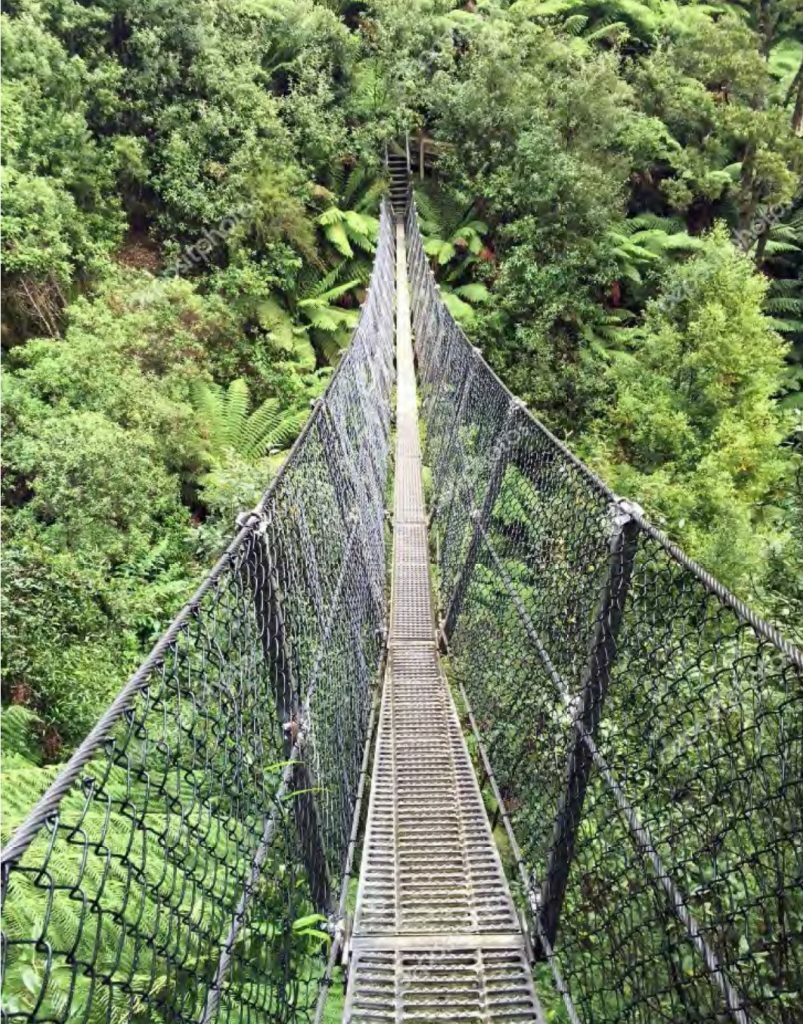
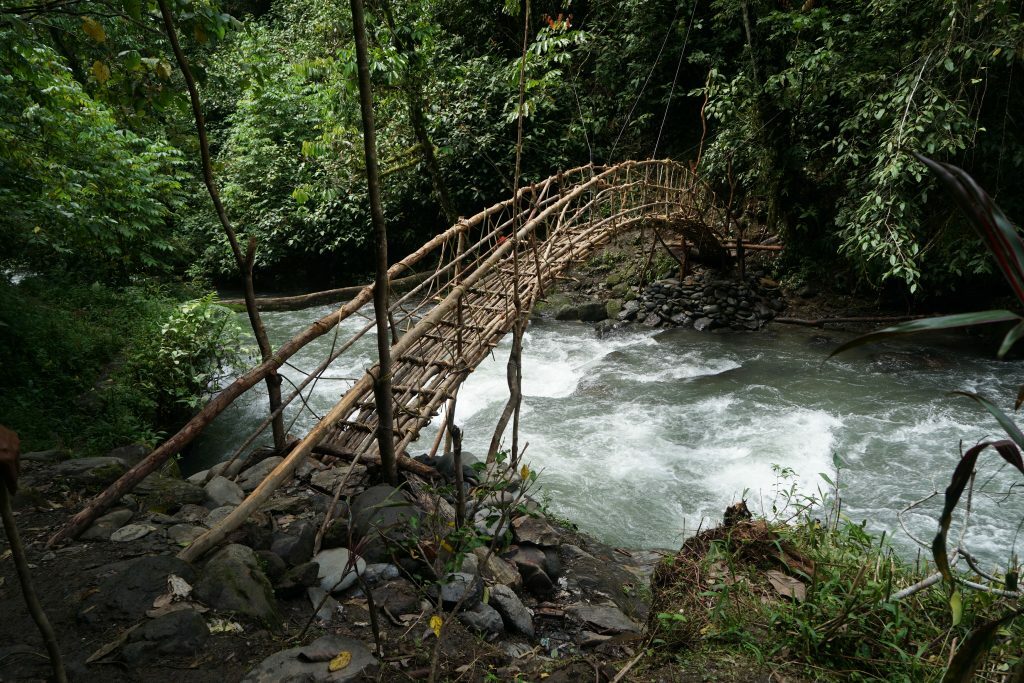
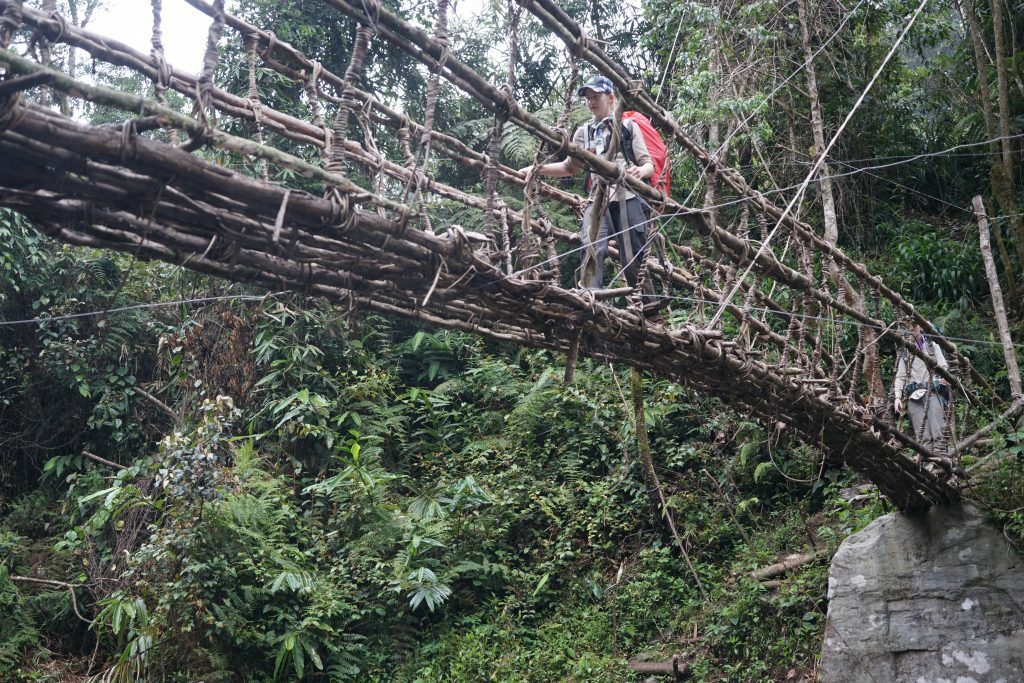
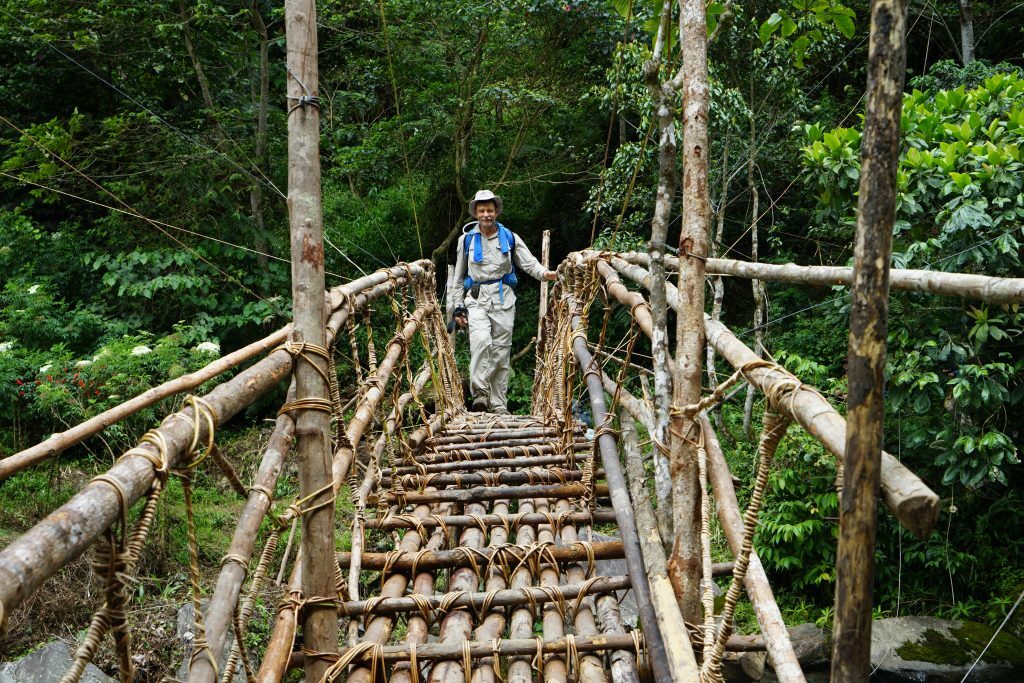
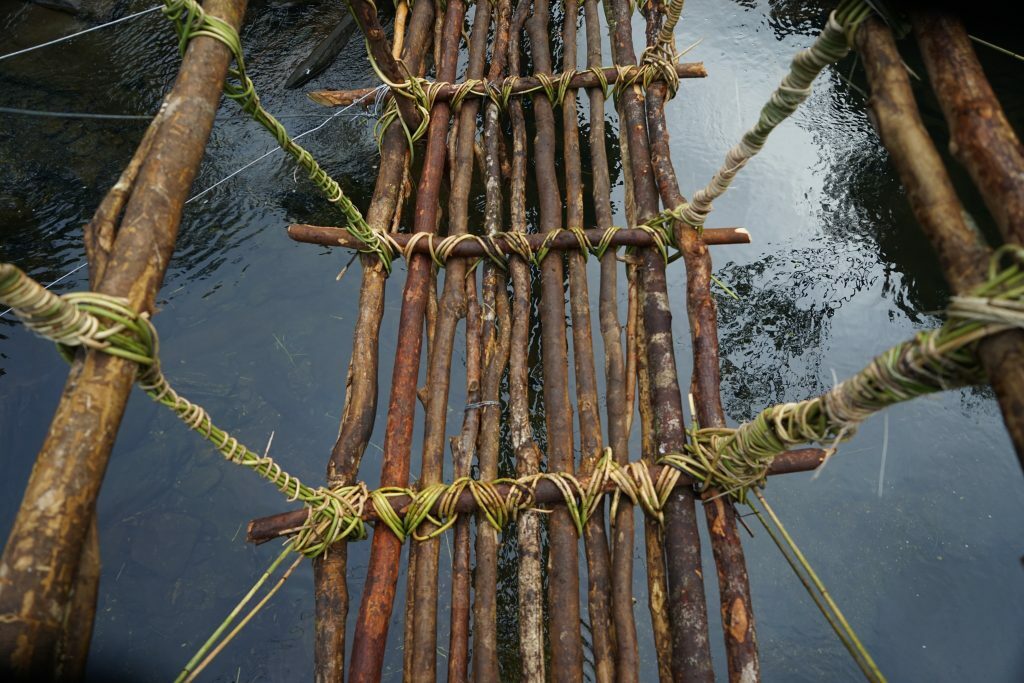 | 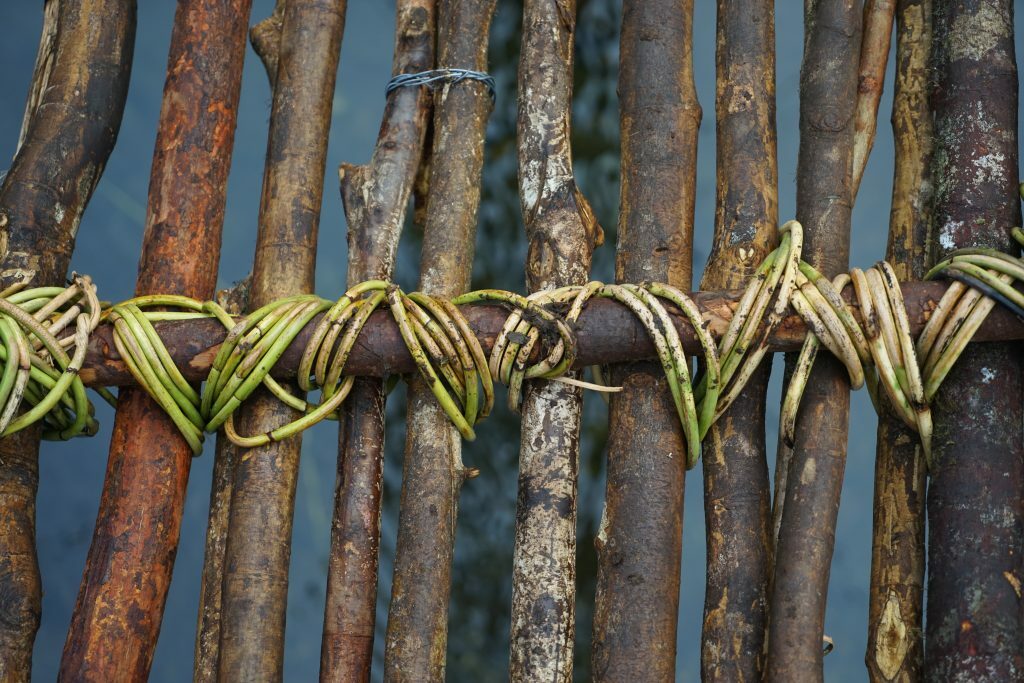 |
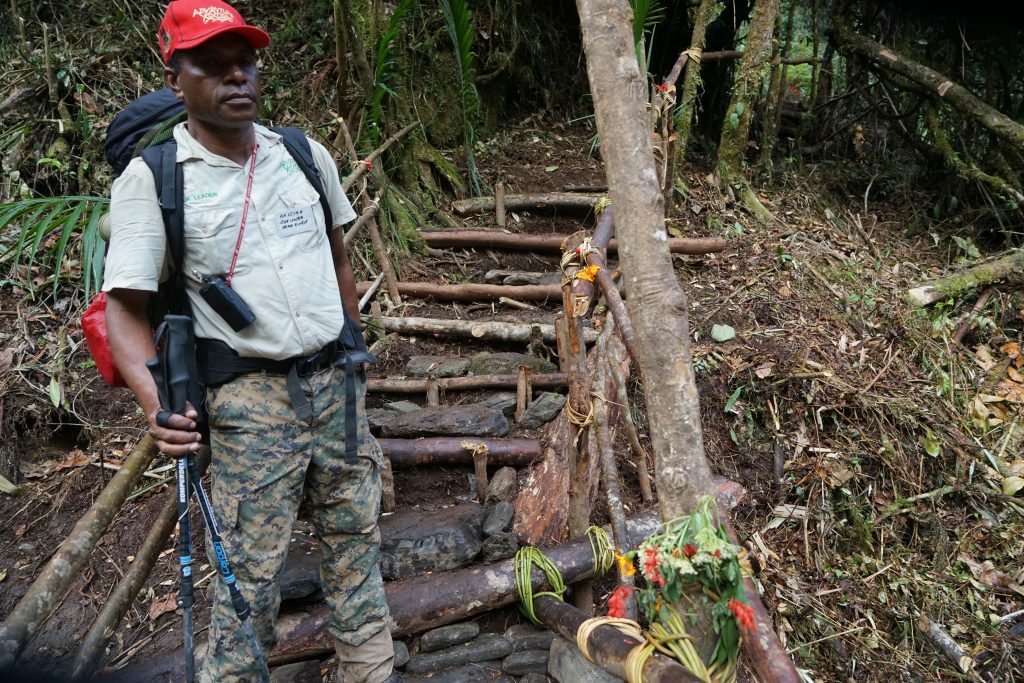
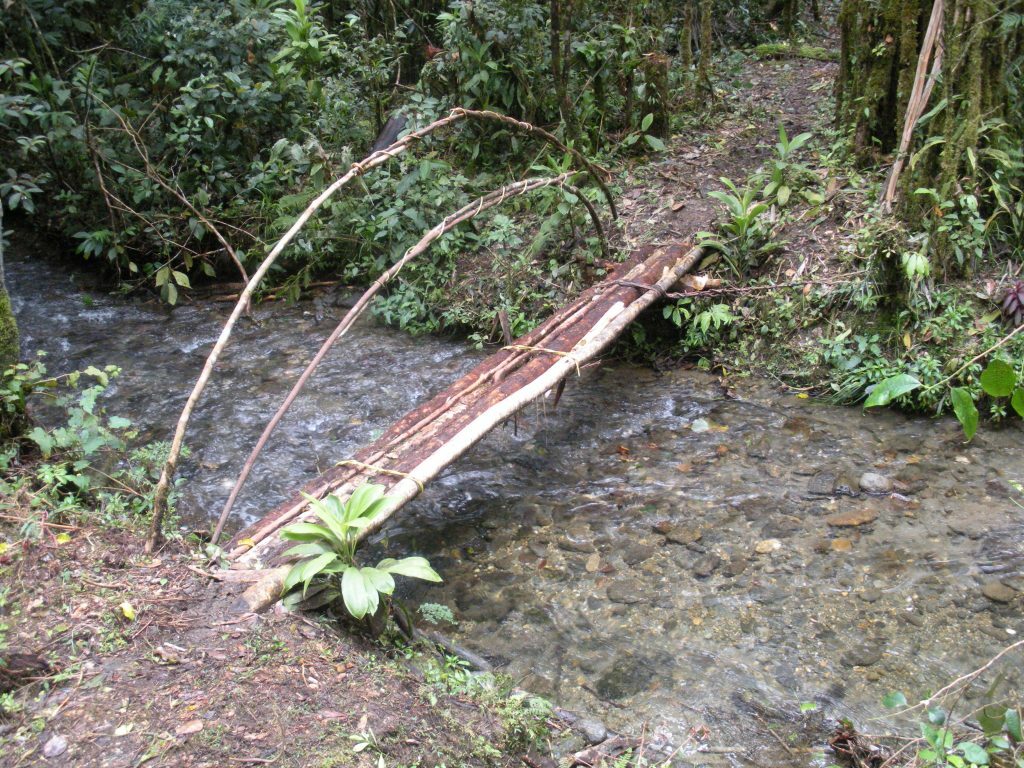
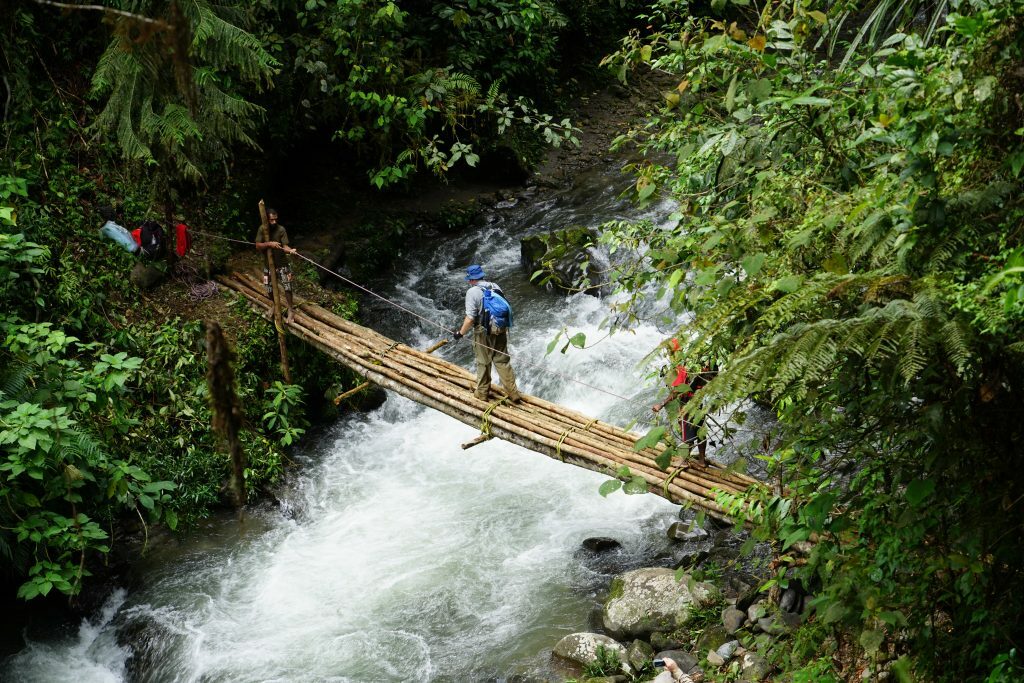
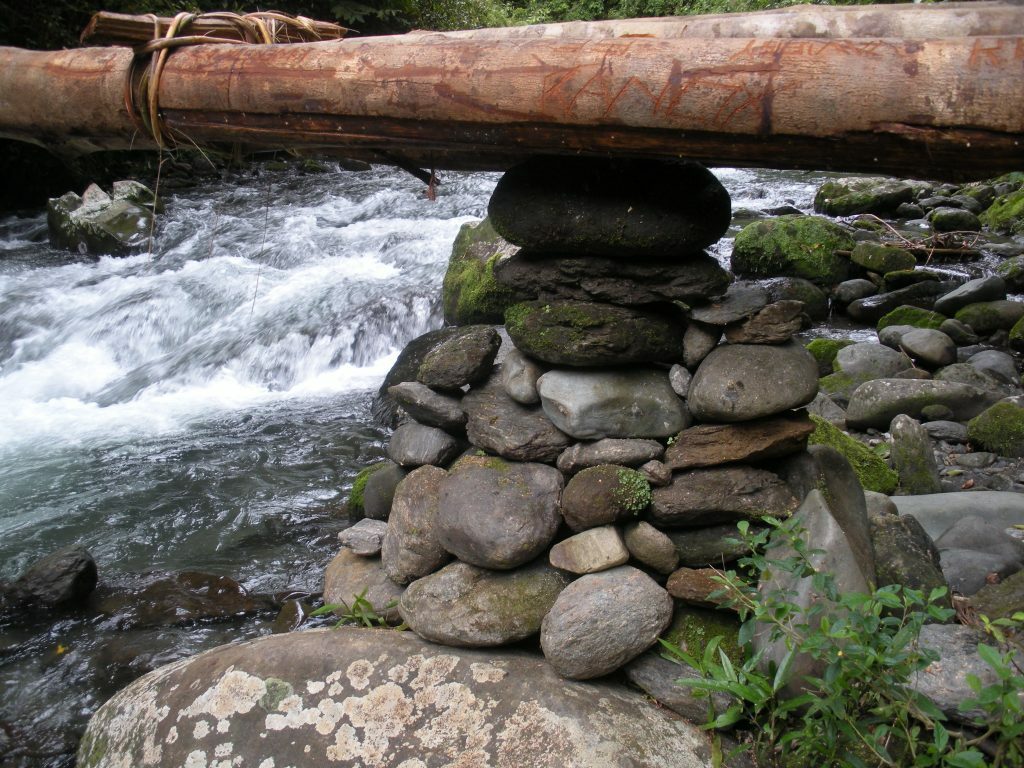
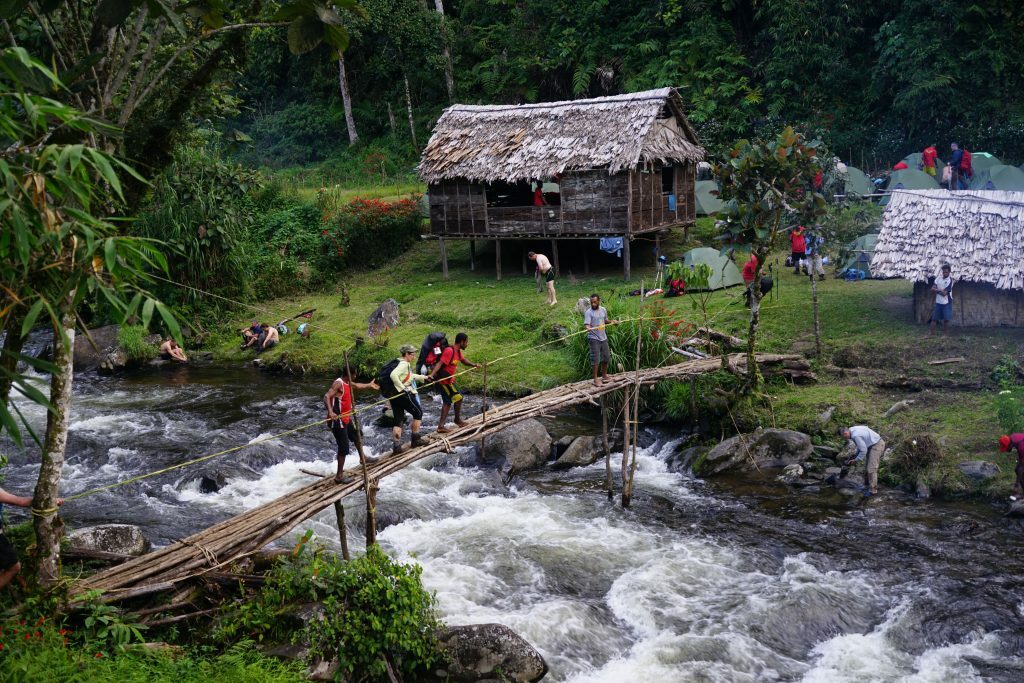
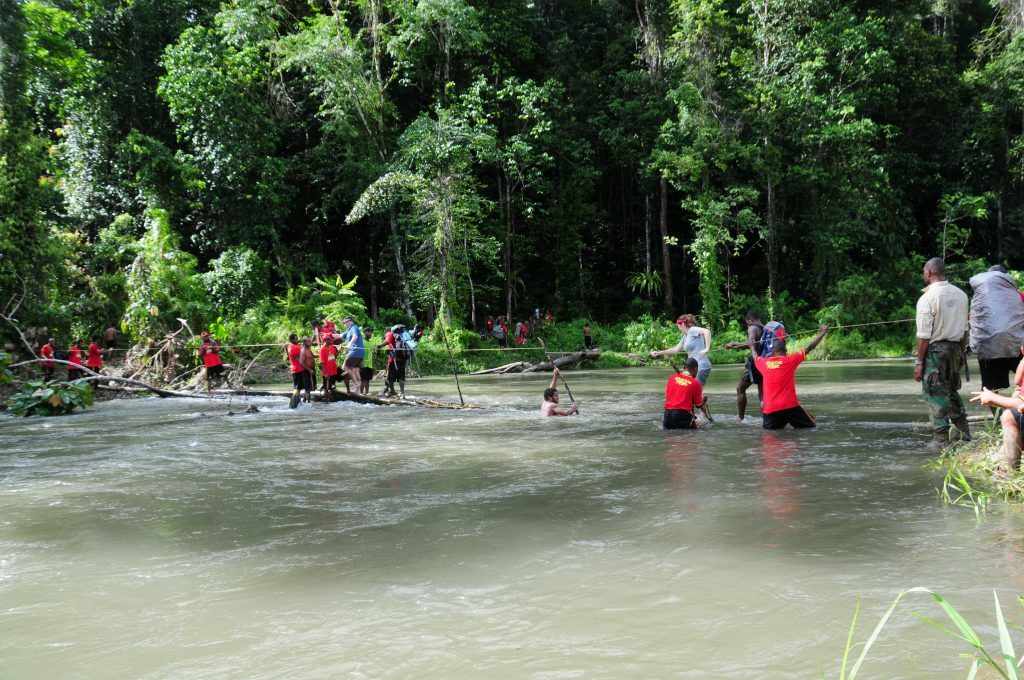
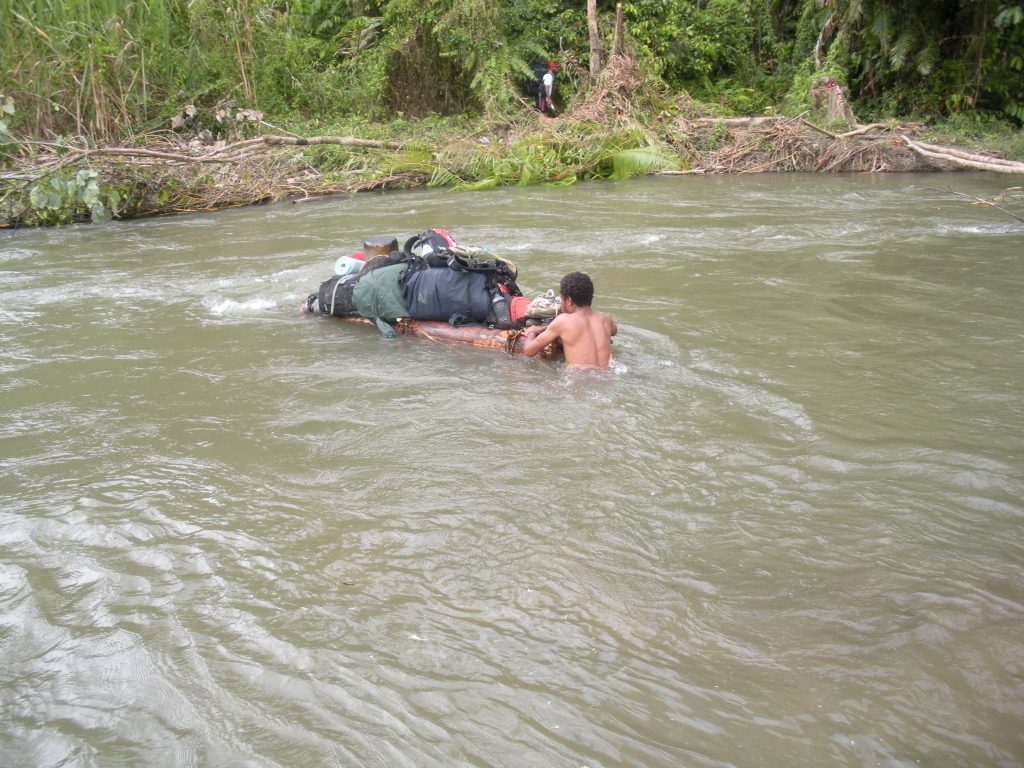
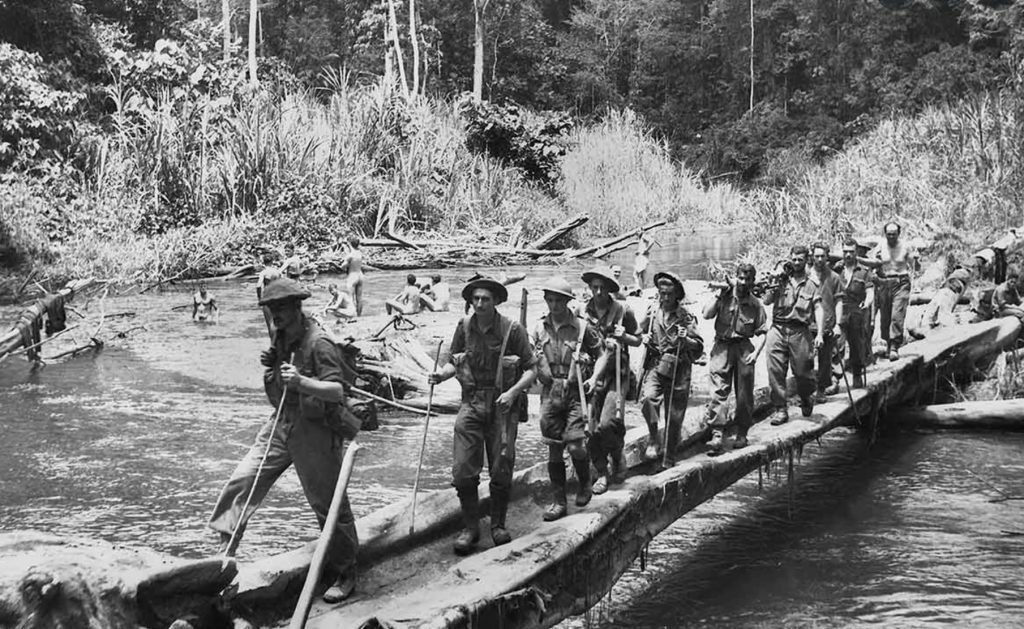
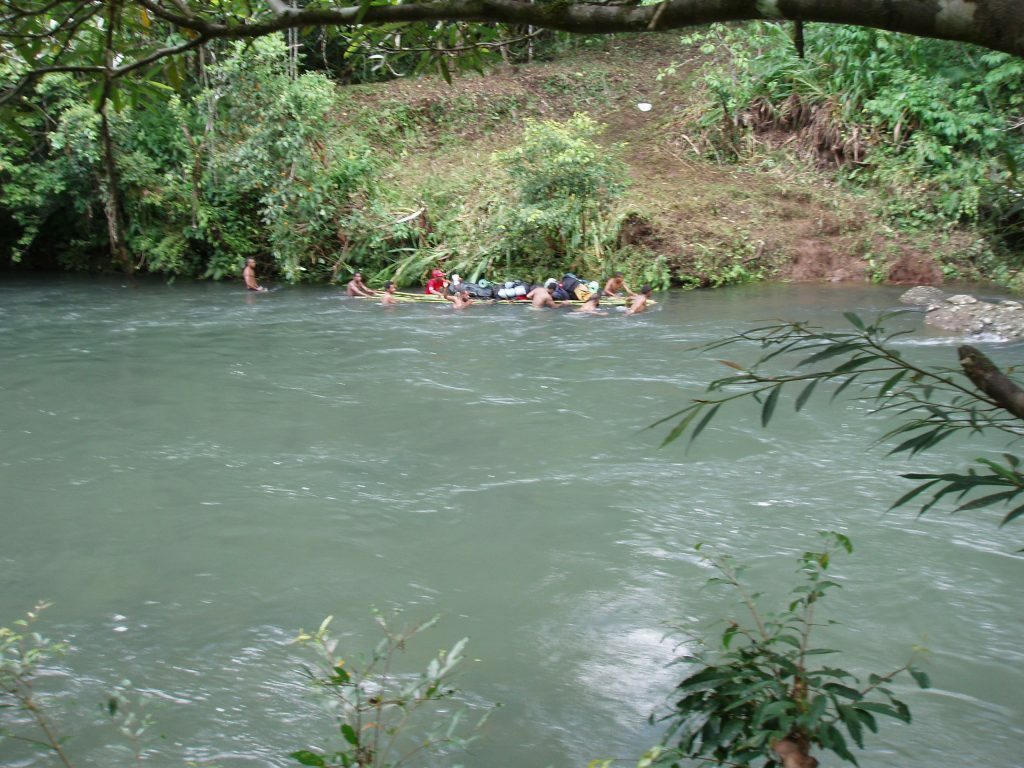
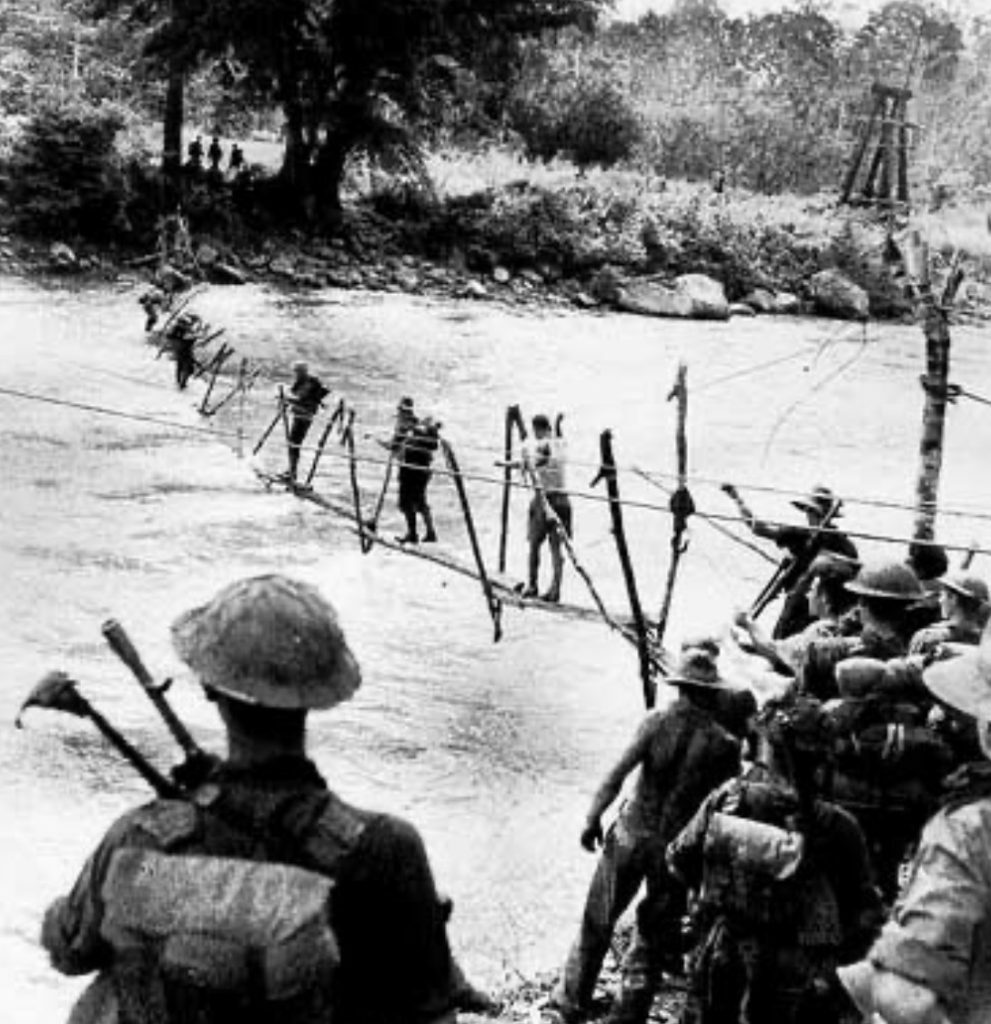

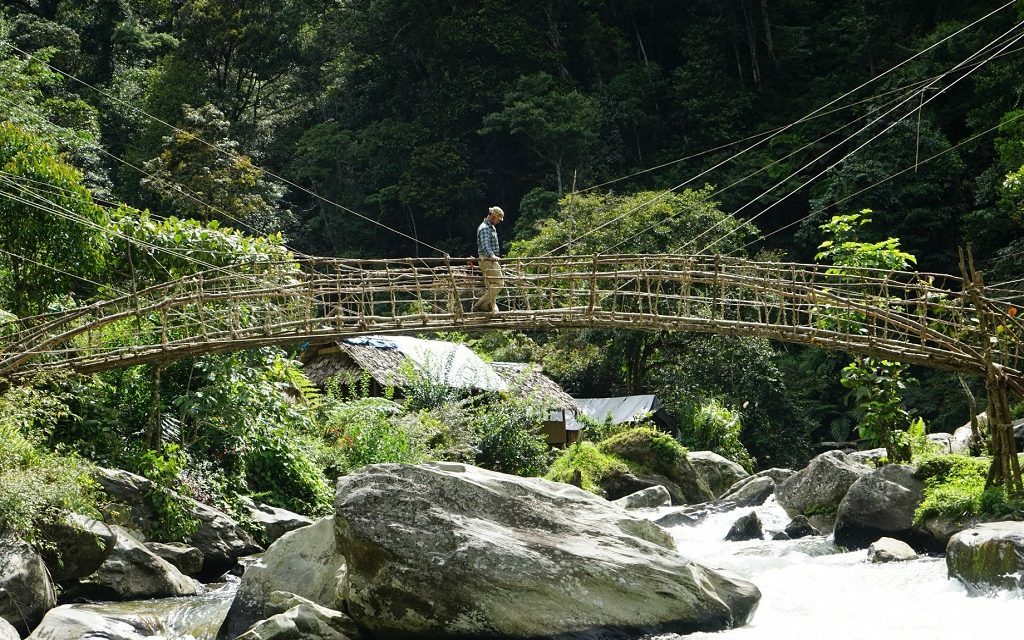

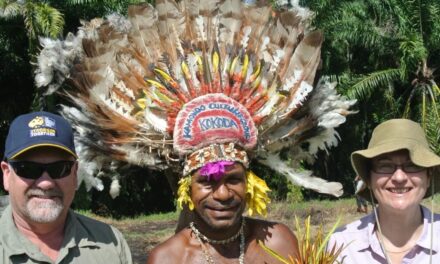

DVA/Minister
I trekked Kokoda with my 14 year old son back in 2011 and we both thoroughly enjoyed the special memories of the trail, its natural wilderness and the tough physical challenge the trail offers to those looking to share in our shared military history and walk in the footsteps of our fallen soldiers.
On returning from that trek I joined the board of Network Kokoda as Director , a board that I now Chair, seeking to give back to those villages along the Kokoda trail who were so instrumental in supporting our troops during the Kokoda Campaign back in 1942. Military historians suggest that without the local Kokoda Villagers the “Fuzzy Wuzzy Angels” Australia would have had a much tougher time defending our land against the foreign foe in the advancing Japanese Army.
Network Kokoda were instrumental in working with the Australian Government to facilitate the $10m in funding by promoting our Military Heritage Action Plan which was adopted resulting in the $10m funding in question.
We welcome all the proposed improvements to protect and preserve our shared military heritage in the region and stand side by side with DVA and the Minister when it comes to implementing these initiatives along the trail.
However, we struggle to see the logic , and hence we are concerned the DVA/Minister may be overlooking the existing benefits to the Kokoda Villagers – the descendants of the Fuzzy Wuzzy Angels from removing the traditionally built river crossings made from natural materials which the villagers earn an income from building and maintaining these bridges to be in good working order during the trekking season. By building larger more permanent metal cable bridges well above the waterline will see the income going to these traditional villagers cease.
The RSL in Australia financially supports the descendants of our military and the DVA and Minister would in effect be providing similar support to these villagers who’s parents and Grand Parents efforts to assist the Australian Military in their time of need were never officially recognised or rewarded for their heroic efforts
Please consider that removing these traditional bridges will take the income from those in the villagers who need it and who deserve it, as well as taking trekkers away from the real experience of the Kokoda Trail and lessen the “I walked in the footsteps” experience , as our troops never had steel cable bridges to assist them while they were being shot at by the Japanese.
My first experience of Papua New Guinea was as a platoon commander in the 2nd Battalion, the Pacific Islands Regiment, Wewak, in 1969 (platoon commander). Walking the Kokoda Track many years later (at the age of 60+) was one of the most challenging and rewarding experiences of my life. To retrace the steps of ‘those ragged bloody heroes’, to understand the sacrifices they made and hardships they endured was humbling, to say the least. It was especially rewarding to know that the trekking industry provides so many social and economic advantages to the local communities.
The very act of crossing the Goldie River on a bridge such as those erected by the villagers in 1942 sets the stage for the adventure of a lifetime.
I stongly urge DVA not to replace the existing traditional bridges, but allow the local communities to rebuild and maintain them as they have so competently done for generations.
Investing in the Kokoda Trail is a necessity for this icon of our sacred and shared wartime heritage, commemoration pathway, and rite of passage.
I don’t believe building and installing prefabricated bridges is where the money should be spent; traditional bridges are part of the experience, bringing indigenous PNG culture together with trekkers.
Personally I’d rather see improved toilets throughout the trail – the existing facilities detracted from the experience and there is vastly improved technology for remote facilities these days.
Effectively improving the heritage aspects of the trail is much needed too – such as the launch point at Ower’s Corner, which should inspire at the start or finish of a crossing.
It is most heartening to learn that the Commemorative Project in PNG is to include the development of a Military Project Plan for the Kokoda Trail. (Why has this taken so long!)
Disappointing that part of the available funds is to be spent constructing permanent bridges along the trail. It is a profound experience to walk the Kokoda Trail knowing that you are following in the footsteps of our war time diggers. To cross the rivers via the hand built bridges by the villagers is all part of this experience. Permanent bridges not only denies important income for the villagers but will detract from the importance of ‘following in the diggers footsteps’.
Upgrading toilets at the villages would be more welcome to trekkers then completing the river crossings over bridges decades more modern than originally used.
I trekked across the Kokoda with Charlie in 2019, (when I was nearly 67years old), something I had wanted to do for many years, as my father & his brother fought the Japanese from September 1942 heading on up to Sepik/Wewak. My uncle was killed in action.
My Dad told us stories of the weather, the pigs and the mateship that he experienced. As his daughters he did not elaborate. My sons heard the real stories from him when they were growing up and have since told me.
One of my sons has also trekked with Charlie taking a group from Punchbowl Boys High. They did it in a much shorter time I think 6 days!!!.
The people of Kokoda are an amazing people.
They live a simple happy life and it would be a shame if you put in pre fabricated bridges where it is part of their lively hood for the upkeep of these river crossings.
To take away the authenticity of the Kokoda Trail as my father and other Diggers had to endure would be tragic!!!
I have trekked the Kokoda trail on the 75th anniversary of the Kokoda Campaign.
I was booked into to do this trek again on the 80th anniversary, but due to Covid my plans were placed on hold.
I am happy that the DVA are investing funds into the History & heritage of the Kokoda trail. I feel if the trail is changed from the original authentic War Time construction, this will deter future Trekkers wanting to do the Trail walk. for them to remember & try to put themselves in the foot steps of our past hero’s, The Kokoda soldiers & also the PNG Fuzzy wuzzy.
I would like the DVA dignitaries to walk the trail before they make the decision about the bridges.
My experience from doing the trail was very emotional for me. I was trying to imagine what it was like for the soldiers. I thank ever Soldier & Fuzzy wuzzy for protect this wonderful country.
While trekking I was told what the Australian Govt has invested into the PNG villages already, & what I remember is that the budget was nearly used up by diplomats trying to make decisions & plans on what was built for the better of the locals. All i saw was buildings empty, not used & in server disrepair.
This is due to the villagers not having ownership. They didn’t build it so the didn’t own it. Why would you repair something that you didn’t like or use?
Also who will be doing the up keep & repairs on the steel constructed bridges once built? They will need repairs & going by past history, the locals may not do this.
I would like to see the DVA give the PNG villagers this funding to build traditional bridges & keep them in good repair. This doesn’t take away the history of the trail & the reason the trails is there. I feel more is needed to protect the artifacts that are left from the War & to stop the people from stealing these artifacts to sell on the black market to make money to live. If they were paid to repair the trail & its heritage infrastructure, this will hopefully reduce the amount of artifacts being stolen.
All I ask is for the Australian govt to talk to the Kokoda Network to work out a plan that will be best for the economy & the locals of PNG.
Look back at history & see what went wrong & where, & not to make the same mistake again.
PNG is a beautiful country & I will be back one day.
With what I have written, if any of this is false information then I happy to be corrected & the truth spoken.
I trekked Kokoda with Charlie in 2017. I come from a family of farmers so not many of my family members were actively involved in WW2. I found the trek a profound experience and was deeply moved by all the stories that we heard along the way. The bravery, the unimaginable hardships of those who fought, and the incredible assistance given by the local population were an inspiration. I believe that the experience should remain as authentic as possible and I am sure that fellow trekkers would prefer to support the locals economically and experience traditional methods of bridge building. It does not appear that there has been adequate consultation with the key stakeholders. Whilst it is obviously a good thing to have access to funding, how it can be allocated in a way that will help the locals and not diminish the ‘raw’ experience that is uniquely ‘Kokoda’ needs careful consideration. The locals have earned our deepest respect and we owe it to them to return the favour and listen to their needs, not just proceed with projects that ‘we’ think they need.
I have trekked Kokoda three times, with each trek finishing on April 24th followed by a dawn service at Bomana war cemetery on Anzac day. The challenge, effort and struggle involved in this trek and the comradeship developed amongst the trekker’s and porters, many who introduce you to their families in villages along the trek provides in most trekkers a life changing and new appreciation on life values.
The physical challenge, the wartime history, the local porters and villages, the natural environment and incredible terrain make trekking Kokoda, for most people, a life time memory with life time friends developed and crossing the many rivers is one of the very memorable parts of this trek.
The idea of installing pre fabricated bridges on any of the river crossing will partly destroy many of the experiences and challenges of this legendary trek.
I believe that investing in Kokoda is a wonderful thing, but has to be done in a way that does not take away the real experience of the track. The creek crossings are a major part of the track if you change that by erecting prefab bridges you are taking away some of the chellagages that make you feel that you can achieve anything.
The beauty of the trek is that it’s not prefabricated paths or bridges that you would life in the National parks. The authenticity of the experience of the wilderness and the conditions that you would want to experience when doing Kokoda.
The bottom-line-up-front is that I do not support the proposal to build prefabricated bridges along the Kokoda trail because such constructions will destroy the authenticity of experiencing the trail in a manner similar to that of our forebear, digger heroes. The constructions will deprive the local villagers of an income in maintaining the crossings as well as reducing the social interaction between the locals and the trekkers. Being physically aided through, or over fast-moving rivers on a locally-built bridges evokes heart-felt memories of the Fuzzy-wuzzy Angels’ efforts in keeping our diggers alive in a hostile environment. Introducing construction companies into the pristine environment has the potential to irreversibly destroy the local environment to the detriment to the locals. Australian aid to PNG is good. But such a proposal is misdirected.
I trekked the trail in 2013. Notice that I deliberately wrote ‘trekked’ and not ‘walked’. My journey was certainly not a walk. At the time, I was 59 years of age. I was in my final of 39 years service as an Infantry officer in the Australian Regular Army. My bother, Philip (aged 51 at the time), together with his two sons, Fletcher (19) and Sebastian (17) accompanied me. Philip, nor his sons, had any military experience. Of interest was that Fletcher’s and Sebastian’s average age of 18 equalled, or was similar to the age of the majority of militia first dispatched to PNG. During the 12-day trek, I witnessed a significant change in my nephew’s attitude to the hardships experienced by their forebears in 1942. I reminded my nephews, often when they were whinging about the hardship they were experiencing during the trek, that they were the age of the diggers who defended Australia from a possible Japanese invasion. I Told them to imagine the additional hardships than that endured by the diggers: having less food than that we were provided by our carriers, carrying personal and crew-served weapons, suffering from dysentry and, most importantly, being engaged by enemy fire and suffering sleep deprivation. If the trail is to be ‘experienced’ then it should remain in its raw state. Whilst it is not possible, I believe that every Australian would benefit from a trek along the Kokoda Trail. Therefore, I urge DVA representatives to reconsider the avenues of enhancing Australian’s access to the trail. There are other ways to build bridges betweenPNG locals and Australians.
I trekked Kokoda with Charlie in 2012 and would hate to think they would build prefabricated bridges . We need to experience the trek as close to what our soldiers did.
Completed the trek across the Kokoda Trail in 2014. Both the Goldie and Brown river crossings were fairly trivial. The water wasn’t deep at the points of crossing and while the Brown had a strong undercurrent, it was fine so long as you held onto the guide rope. I don’t see the advantage of adding bridges here, they would as mentioned take away from the heritage of the trail.
Of all the other crossings, there were only two of note for me where I could see permanent bridges built, purely from a safety factor:
– somewhere between Menari and the foot of Brigade Hill
– somewhere between Abuari and Isurava
The bridges constructed by locals at the time were absolutely fine, the only point I would make is around the fact that both bridges were a bit higher off the water than others, and the second was over fast running water and rocks, making it a little nervy crossing them fully laden (as I was) and sometimes on my own as the group thinned out over the day. In both cases the footing was fine, but there was only a rope to hold on and keep balance. A wrong move could’ve be fatal.
I’d be in support of having ‘safer’ bridges at these points, but it’s my understanding most of the bridges built by locals tend to wash away with major storms etc. Also, it seemed locals didn’t take too kindly to foreign built structures, often met with avoidance, vandalism or straight out destruction.
Seems the solution to me would be to either:
A: don’t change anything and have locals build temporary bridges as they do today
B: have locals build more permanent and safer bridge structures over the more riskier crossings in a way that still respects the feel of the environment
I trekked the Kokoda Trail in 2016 at age 64 as it was something on my “bucket list” and it was without doubt the most challenging experience physically, emotionally and mentally that I have ever undertaken. Part of the buzz of the trek was to be able to do it in similar circumstances and conditions to those that fought there during the war. A big aspect of that was traversing the creeks and rivers using makeshift bridges built and maintained by the locals tribes. To even suggest that these bridges be replaced with modern prefabricated bridges and therefore lining the pockets of corporations rather than local indigenous communities shows very little understanding of what the experience of the trek means. To “soften up” the trek would be detracting from the whole point of doing it.
I’ve walked the track with each of my two sons and are booked to take my daughter next year for my 3rd trek subject to restrictions. I think the bridges the locals built are very sturdy and rigid and fit for purpose. I think erecting prefabricated bridges would be a big error and certainly detract from the trek. A big part of doing the trek is to experience how the diggers did it and not have everything changed. My preference would be that any money allocated for these new bridges could be given to the villagers to maintain the current bridges and to retain the current authentic experience.
I walked the Kokoda in 2014 with my son as part of a school group. It was hard work but exhilarating. The river crossings were a real highlight and feel that if some of these were replaced by prefabricated bridges the whole experience would be diminished. It is great that money is being directed towards the trail, however I think there may be better uses for it than pre-fab bridges.
Why do Australians look forward to trekking the Kokoda track in the first place. I’m of UK origin arriving in Sydney in April 1962. Notwithstanding, with Australia Citizenship, I served with the Australian Army Reserves as a field engineer for some 16 years. The Kokoda campaign saw fierce battles from all parties with tragic losses on all sides. I trekked Kokoda during April 2007, to not only pay my respects to those that fell before us, but to experience for myself the authenticity of the Kokoda Track, in conditions that best represent the conditions that our soldiers endured, along with experiencing the ruggedness of the country itself and its wonderful people. I can appreciate a need to provide safe crossings for PNG families but don’t build prefabricated bridge crossings under the guise of assisting trekkers without first asking interested parties along with PNG locals if that is what they want or need. Of far more importance is the provision of toilet and septic waste facilities, particularly in the current pandemic environment. Thank you for the opportunity to comment. Lest we Forget 🌹
I trekked Kokoda back in 2015 with Charlie . I loved that the trail was untouched and challenging it really would be a big disappointment if they start putting prefabricated bridges up through the trek to try to appeal to more trekkers ..? Because I think it would actually do the opposite and less trekkers would want to trek it .
Please leave the trail with the traditional Bridges
I did the Trail when I was 60; my father did it when he was 26 in 1942 whilst being shot at by the enemy. We both had authentic experiences of our day.
Charlie is right. It would be a travesty to soften up the Kokoda Trail with modern engineering river crossing structures. I have seen many such steel suspension bridges in Borneo and NZ, and frankly they look so out of place in the jungle.
Look at any Kokoda trekker’s photo album and you will find lots of pictures of the trekker on one of the wonderful locally made crossings. To cross them is a thing of pride and a right of passage. No two are the same. They are works of art and a real thrill and live in one’s memory for a lifetime.
I am happy to pay a maintenance levy to assist the locals with the upkeep
I share Charlie Lynn’s concerns and support his suggestions
What a bloody disgrace! What’s next? Perhaps they could build 90km long airport travelator so that people don’t have to walk!!!
The experience of getting wet boots at my very first creek crossing at Goldie Creek within the first hour of the trek which started wet for 9 days is something that I still tell people about years after completing this magnificent journey.
Somethings are better left the way they are…
Charlie,
I was horrified to learn of the DVA’s proposal to construct prefabricated bridges across the Goldie and Brown rivers (and two other unspecified rivers).
As you know, you have now led three separate trips for me and the year 11 students and mentors we take up to trek the Kokoda Trail, as a rite of passage model.
This recent proposal flys fair in the face of what the Kokoda experience is supposed to be, and goes totally against the grain of how it is promoted. More and more destinations around the world are being spoilt by the visual intervention of modern technology and western invention. These traditional methods of bridge building by local villagers never fail to amaze and impress all of the trekkers we take up there, which creates an unmistakable air of authenticity, with the realisation that these bridges are the same as those that the diggers had to contend with and cross in 1942.
This current situation reminds me of a comedic scene in a Paul Hogan movie, when he was trying to tell the viewers that the local aboriginal people were living exactly as they were 40,000 years ago and had very little contact with the “outside world” …. camera pans out, and they are wearing watches and Nike running shoes.
The DVA should also take into account the sense of belonging to the big picture that this provides for the local villagers, to be able to demonstrate their ingenuity and traditional skills to many trekkers every year, by these descendants of the fuzzy wuzzy angels.
I can tell you now, without doubt, THE most photographs taken and funny stories told, all revolve around the bridges and crossing of same.
Guess what DVA decision makers ? This is exactly the reason why people are attracted to PNG and trekking Kokoda.
People are bored to death with 5 star hotels, room service, OH&S guidelines around the resort pool etc.
For God sake, our young Australians need to experience some sort of adventure, somewhere, before all of these destinations rapidly disappear.
When I wrote about my experience and observations soon after trekking the Trail with Adventure Kokoda, this wasn’t what I had in mind when spoke of the need for footbridges. Even still, if safety and sustainability is leading the drive for improvements along the Trail, footbridges should be the least of the worries. That’s if we’re prioritising the well-being of the PNG Carriers (Porters) and Guides, and subsequently trekker tourists – predominantly Australians. But I’m not sharing my homework (again). And I’d also like to hear the views from Kokoda Trail communities about these proposed footbridges. There must be some end to this infuriating pattern of Papua New Guinean voices directly impacted, but not consulted, in decision-making about Kokoda Trail issues. Surely.
I’m going to leave this sort and simple. I trekked the Kokoda Trail in 2019 at the age of 21 with Charlie Lynn leading the way. I strongly oppose the building of prefabricated bridges along the trail as I believe it would detract from the natural and bare experience the trek is all about. It also deprives locals from eating money by constructing and maintaining traditional bridges. At least consult those whom it would affect the most (the locals) before commiting money where it is not required or needed. There are much more pressing issues that the money could go towards on the trail and Charlie Lynn would be a good person to talk to for reference.
In the so-called era of evidence-based policy making this appears to be a proposal in search of evidence. Where is the need, evidence and case made out for spending taxpayers dollars on changing Kokoda with the bridge proposals? Who supports it? Where have they stated as much and why? How did this proposal come into being? It’s out of step with the best interests of Kokoda on many levels.
In my experience, having trekked Kokoda in 2012, the authenticity, local character and historical accuracy of the trek is so vital, and should take precedence. The unique, timeless and functional current arrangements for river crossings are indeed an essential part of the experience. If it ain’t broke, don’t fix it.
Moreover, there are far more essential projects and causes worthy of Australia’s support along the trail for instance in health and education.
I strongly oppose my tax dollar being spent on this ill-conceived, evidence-free, unnecessary proposal.
Having experienced the the Kokoka Trail with Charlie Lynn back in 2012, one of the best memories is of the team making its way across the rivers with the support of our local crew. This is the way it was and should be the way it stays. What is the benefit of pre-fabricated bridges? Even if these did not cost $1 of taxpayers money, it would be a detrimental thing to do, impacting the locals and also completely changing the experience of the Kokoda Trail. Please leave things as they are with the bridges .
I trekked with Charlie and the river crossings were a real highlight, I hope the remain how they are so you truly get the full experience.
I did appreciate the authenticity of the natural bridges and it did add to the experience and emotions of the trek as my grandfather experienced before me during his campaign.
The experience in its entirety made me feel connected and extremely proud to understand the conditions endured by our hero’s.
For the bridges as stands, if there is a risk management process that completes a risk audit that deems it safe for travellers and locals, then I would be happy to see the natural bridges remain.
If it is the thought that improved bridges would bring in more business to local communities, it wasn’t the bridges that were the toughest part of the trek. The bridges were the least of the challenges facing a trekker.
The bigger risk that I could see was water supply. The money may be better directed to providing water to sites and potentially filtered vs having to go to the flowing water side at any time day or night to gather water for consumption. The same water that you drunk, washed dishes and bathed in.
Improving water quality and access would also improve the quality of life for the local community.
I witnessed what a simple case of conjunctivitis and how it harmed a child in a way that western living would never tolerate.
Having the investment in the region is wonderful but I would hope it is assessed where it could benefit the most with best outcomes.
6 years on and I still encourage all to participate in this trek. The experience, the people and the history are something that deeply moved. Keeping the authentic trek so others can experience and learn what courage, endurance, sacrifice and mateship is something we should preserve for the next generations to experience and appreciate and share lessons learnt to their families.
There was no doubt what I appreciated about the Kokoda Adventure trek i did with Charlie Lynn was his critical support of the local communities. This included the many infrastructure projects along the way such as the river crossings. These structures for example supported the local villages, including important upkeeps of those structures. The local people know best, they should be the ones dictating any decision to be made about these structures. Finally, crossing these bridges made the trek authentic and added to what was an amazing experience of the local people and their culture.
From Tom Hayward
Well intentioned though it is, I do not support the concept of fabricated bridges as intended. The locals know best and I believe they will want to build, keep and maintain their traditional bridges. It is an often-made error that this topic has not been discussed with the traditional owners. Separately the fabricated bridges are not in keeping with the whole Kokoda experience and mindset.
I trekked the Kokoda trail in 2019 , the trek needs to be authentic and as close to what the diggers went through to understand the conditions and hardship that they experienced during the WW2. The bridges for me were a fantastic experience and seeing the guides look after the trekkers while crossing the bridges will always stay in my mind. On our trek when we got to the Brown river it was raining anyway and we ended up walking through the river, so no point in a fabricated bridge. Lastly the best photos and stories are from crossing those locally maintained bridges I have a few good ones!
I completed the Kokoda Trail trek in 2019 with Charlie on his 97th crossing. Margaret Ryall who commented above was on the same trip.
The river crossings are part of the experience, and a good one at that. Walking across a slippery log with a bit of rope for “support” with a torrent raging below is quite a buzz. Conquering these challenges is part of the sense of achievement that drives you to go in the first place. You start walking the Kokoda Trail for an adventure, but as you experience the difficulties of it and come to appreciate the bravery, endurance and sacrifice of those who fought there, you end up completing it as a pilgrimage. After completing the trail and returning Port Moresby and Bomana War Cemetery, one of my fellow trekkers said to me “I feel like I should stop at every headstone. It feels wrong to just walk past them.” I couldn’t agree more.
My advice to the DVA types would be to support the villagers, preserve the history, and leave the challenges authentic. If you do that, you will respect the sacrifice of our soldiers and preserve an ongoing income stream for the villagers.
There have been various comments about improving toilets on the trail. I support them, but do it for villages and trekkers.
The traditional bridges were all part of the experience. There is no need that I can see to replace them with prefab. The money could be put into many other projects that the locals actually want.
I have trekked the Kokoda Trail 4 times with you and Chad. The water crossings of the Goldie and the Brown rivers are two of the trek highlights! Working with the locals to get across safely while enjoying the local engineering using timber, vines and ropes is a real joy and part of the experience. I would rather this money spent on improving the health, wellbeing and education of the villages.I look forward to my next trek with no bridges. Sincerely Davi Egerton-Warburton Perth, WA
As a ‘Kokoda Youth Leadership Challenge’ trekker and young future leader, I see great importance in preserving and maintaining as many components of the trail as possible to give everyone the experience to walk in the footsteps of our Diggers. From my experience, trekking over the bridges were some of the scariest yet most exhilarating moments. We had lots of rain, making the bridges more slippery and more humbling. Even though these bridges frightened me, I believe I would be less attracted to re-trekking the Kokoda Trail with prefabricated bridges. This is attributable to purely wanting to do Kokoda to put myself in the shoes of the Diggers and challenge myself physically and mentally.
If they did not have prefabricated bridges, why should we?
My foremost curiosity is how many DVA have trekked across the Kokoda Trail and the original bridges. For them to be even considering this decision shows me that minimal people from the DVA have experienced the natural conditions of Kokoda, as if they have, they will realise that the environment’s unpredictability makes Kokoda, Kokoda.
Kokoda is a challenge and an adventure. It is not meant to be easy.
If it were easy, would it be as memorable? Or as life-changing? Or like it was in World War II?
No, it would not be.
So, why should we fix something that is not broken?
The DVA potentially perceives these prefabricated bridges as a helping hand to relieve the local villagers of their duties of constructing, repairing, and maintaining these bridges. However, this annual task is a part of who they are and what they believe in. Hence, if these bridges are constructed, it ultimately destroys the PNG villagers tradition and an aspect of their livelihoods.
Therefore, the DVA officials have prematurely judged the PNG’s needs and wants, demonstrating their lack of empathy. This results in the implementation of irrelevant strategies, such as the prefabricated bridges, that neither benefits PNG nor Kokoda villages.
PNG’s have simplistic and subsistence lives. The DVA needs to adapt in correlation to the Melanesian culture, not a westernised society.
DVA, ask the opinions of the local villagers and past trekkers on an initiative like the prefabricated bridges. Do not just assume.
The $10 million investment for commemorative projects in PNG, including the development of a Military master plan for the Kokoda Trail is welcomed news and an investment which is long overdue. I do not agree that part of this investment should be used for prefabricated bridges at the Goldie and Brown Rivers and other locations as these funds could be better spent elsewhere.
Trekkers want an authentic experience when they trek across the Kokoda Trail. The river crossings make it a memorable and an exciting part of the journey. I will never forget the local carriers construction skills when a temporary bridge was required, their deft hands in leading you safely across the bridge and the joy shared with the group in the successful crossing.
There will be no benefit for local communities from prefabs, it would be better to pay the local communities to build and maintain traditional bridges along the Trail whereby offering them an opportunity for additional income. I urge the DVA not to implement the plan for these bridges and stay with tradition and let the local communities manage these crossings and allocate the money for the prefabricated bridges elsewhere.
Until WW II the only ‘manufactured’ bridge along the Kokoda Trail between Buna and Port Moresby was at Wairopi (Tok pisin for wire rope), destroyed by 39th Battalion soldiers to hinder the Imperial Japanese advance in 1942. The Trail’s traditional owners and both armies had to use log bridges or wade at river crossings. Australian Army engineers built roads, fords and bridges from the coast to Kokoda in the early 1960’s; many of those bridges were destroyed by Cyclone Guba in 2007.
During the WW II campaign well-known movie footage shows “fuzzy wuzzy angels” carrying wounded Australian soldiers on stretchers across Eora Creek. Another image shows our soldiers crossing the Brown River on an enormous log. Seasonal rain washes out log bridges every year; local landowners replace them whenever necessary.
A traditional ‘Highlands’ cane bridge was built across the Brown River around 2000; locals had closed the Kokoda end of the Trail; six months later, when the Trail re-opened that same bridge had been washed away. At Eora Creek around 2015 another ‘Highlands’ cane bridge, (reinforced with No. 8 fencing wire) was built. Its timber crossbars broke after a season. A similar cane bridge at Templeton’s Crossing also lasted just one season. The approach tracks and abutments often need to be remade, leaving an isolated bridge, or flooding might wash away the bridge altogether. Bridges need to be inexpensive and easily replaced. Bundled log bridges were traditional along the Kokoda Trail for those very reasons.
I’ve crossed on modern 9mm diameter wire rope bridges, sometimes with galvanised expanded metal footways, in different locations in PNG. Seemingly permanent, they are costly to make and install; their weight leads to their downfall when anchor points fail; or rain washes out their abutments. Prefabricated wooden bridges, unless treated against rot and insects have exactly the same problems: everything in tropical bush rots or rusts.
Regarding costs, anything Prefabricated incurs delivery and installation costs. Better to pay agreed amounts to the local landowners so that the community benefits directly and has a vested interest in maintaining the bridge and its surrounds. Such constructions remain fitting tributes to the “fuzzy wuzzy angels” and our Australian soldiers!
In 2014 I had the opportunity of walking the Kokoda Trail with my son Ben. It was very special for me to do with my son as my Grandfather was on the Kokoda Trail during WWII. Obviously, we did this much easier than him and all of the other soldiers but I feel building modern bridges should not be done. It is a move away from the authenticity of the trek. Also the bridges we walked across were an insight into local culture and building skills of the local community. New bridges will take this away.
By chance I am in the photo above titled “Local bridge across the Vabuiagi River between Menari and Loni villages” and I look at the photo and how beautiful the scenery looks. If I was walking across a modern bridge this scene would be far less impressive in my mind.
I encourage you to reconsider and recommend diverting same funding to local natives to pay them for building bridges to a certain standard you may require. Plenty of examples are in above photos.
The Kokoda Trail is living history. The trail changes each year with the seasons as the rain washes away the old and the jungle grows as new. This is what makes the trek such an authentic and singular experience. There is a delicate and intricate balance between the timeless nature of the jungle and the local villagers who build and shape their houses and dwellings including their bridges and crossing points according to the circumstances of the seasons. Living in such an ever changing environment is a challenge that requires patience, resilience and persistance. Most of all to live in such an environment requires a connection with nature. The local river crossings are created to remain in balance with nature. These bridges and crossings last only as long as the seasons permit and the process of maintaining and rebuilding these crossing points is an expression of the respect and devotion that the local villagers have for their land. The real cost of prefabricated bridges is impossible to measure as the landscape is altered by the foriegn material and the aesthetic is spoilt by an expedient solution to a problem that does not exist.
I implore DVA to listen to the voices of the local villagers and not to impose a solution to a natural cycle of growth, loss and re-growth.
It’s great to hear that there is $10M to be spent along the trail as there are definitely improvements to be made. However, such improvements should not just be made in the interest of tourists who wish to breeze through the trail like a Sunday walk but in the interests of those who live off the trail. Building prefabricated bridges will be a detriment to the locals way of life as well as to the authentic experience of walking the trail.
I trekked Kokoda with my 12-year-old son in 2019 and it was one of the greatest experiences of both of our lives.
The landscape, history, and local people throughout the region all combine to make this one of the most unique environments anywhere in the world.
Whilst I support any government initiatives to help the villagers of PNG and preserve the military heritage of Kokoda, building prefabricated bridges across the rivers will not help anyone.
Sometimes the best of intentions completely miss their mark, and this is a classic case of a bureaucrat in an office, not understanding the needs of the locals and the detrimental impact that these bridges will cause.
Hats off the to the DVA for offering up this desperately needed funding, but please consult with and listen to those who have dedicated most of their lives to the people and history of this region…………Charlie Lynn!
I am sure the money can be spent more wisely.
I trekked the Kokoda Trail in 2008 in memory of my Father and Uncle who fought for Australia on the Trail. New bridges are needed but only if they are made by the locals to support them as they supported our forefathers and saved many of their lives. The experience of the Kokoda Trail is in memory of those who fought and saved Australia and to the many who lost their lives and those who did survive, many who went on to live with nightmares for the rest of their lives and many whose lives were shortened by sickness such as cancer from the horrific experiences they endured. We trek the Kokoda Trail to remember and to relive as much as we can what they went through, to ensure it never happens again. To install prefabricated bridges across the Goldie and Brown Rivers – and at two other unspecified locations – across the Kokoda Trail is wrong and takes away from the experience and people will forget how hard it was and those who suffered for us.
Please support the PNG local village communities the opportunity to earn additional income by building and maintaining traditional bridges across their land. We need to support them and thank them for keeping our men alive. When I trekked the Kokoda Trail in 2008, my porter was a grandson of a Fuzzy Wuzzy Angel. A Fuzzy Wuzzy Angel who kept my Uncle and many others alive, please remember and support them in providing them the opportunity to build and maintain the traditional bridges on their land. Our lives in Australia would be so different today if it wasn’t for the Fuzzy Wuzzy Angels. My Father (may rest in peace) would not talk much about WW2, but one thing he did say to me was “if it wasn’t for the Fuzzy Wuzzy Angels, many more men would have died”.
I trekked the Kokoda Trail in 2019 with my father. I was 12 at the time and found it to be a truly memorable experience.
Whilst I appreciate the sentiment of introducing this military heritage plan, I believe that these prefabricated bridges are not the way to go about it. I personally believe that this would ruin the experience of the Kokoda Trail as a whole and would also harm the economies of local village communities that construct traditional bridges for us trekkers. It is unnecessary and unappreciated to add these prefabricated bridges because their traditional counterparts are already safe as is.
From being able to personally experiencing the Kokoda Trail myself, the landscape is its most defining characteristic, and if these prefabricated bridges were constructed, this aspect of the Kokoda Trail would be ruined completely. It is unfortunate to know that sites such as “The Library of Alexandria” in Egypt have been lost, altered, or severely damaged due to human actions. This I, for one, would want the Kokoda Trail to remain as it was when I trekked along it for the following generations to have that same experience. Changing a part of the Kokoda Trail changes its value, its importance. The achievement of being able to go make it to the other side of the Kokoda trail would lose part of its challenge; being the same terrain that diggers decades ago had to traverse. For example, if Mount Everest had sections with modern-day rock climbing handholds, it would drastically change the experience and achievement of reaching the mountain’s summit. I know it may sound like an immature example, but it is reflective of the immature decision to add these prefabricated bridges along the trail. It is not a necessary or wanted change and would cause a negative alteration to the meaning of the Kokoda Trail.
The choice of adding prefabricated bridges to the Kokoda trail will also hurt the economies of local villages that construct and maintain these traditional bridges. To not only change the experience of the Kokoda Trail, but also revoke a source of income for local villages is an insensitive decision. This military heritage plan should include support for descendants of those fuzzy wuzzy angels that helped our diggers those many decades ago, not harm them. We need to remember that the Kokoda Trail is not just a 96-kilometre track across Papua New Guinea, but is filled with an extensive history. When I trekked the Kokoda trail, it was an almost unreal experience to know that these were conditions alike to how the trail was during the war. Thanks to the efforts made by local village communities to preserve the trail at that point in history should be appreciated more. Building prefabricated bridges over the trail that those same local village communities had preserved for so long is quite disrespectful, to say the least. It should be in our best interests as a community, as a nation, to support those that help keep the trail in the state it is for future generations to thoroughly enjoy.
In sum, I, as well as many others in these comments have expressed that the addition of prefabricated bridges to the Kokoda Trail is an unwise decision because of its effects on villages’ local economies and the effects it has on the experience of the Kokoda Trail as a whole. I shall remind you of the true meaning of “Lest we forget” being “It should not be forgotten”. Our soldiers should not be forgotten. Family should not be forgotten. Our nation’s history should not be forgotten. For a now 14-year-old student to understand that more than the Minister of Veteran Affairs is a compelling sign that younger people like me can, should, and will express our thoughts and should not be disregarded.
I have trekked with Adventure Kokoda twice in 2010 and 2012. The river crossings were one of the highlights of the trip. The authenticity of the trek is the appeal. We get to be immersed in Australian history. Pre Fab bridges are not nessecary. Keep it the way it is.
The stark reality presented to modern-day trekkers of how removed from civilisation one can find themselves on the Trail is, I found, one of the most profound and challenging pillars of the Kokoda experience. The mettle, courage and resilience required to face such a challenging landscape pushes trekkers to test themselves, dig deep, and experience the Trail in its truest form, “just how our Diggers did it”. To remove any aspect that makes the experience of trekking to Kokoda exactly what it is today would do a serious disservice to future trekkers, and the memory of our Diggers.
I was a part of the KYLC in 2016, and as I’ve said to many friends and family members since, nothing quite prepares oneself for the challenge, the experience, and the beauty of the Trail. Seeing attention and funding being granted is fantastic, but I, like all those who have properly faced the challenge of Kokoda, see the authenticity of the experience to be extremely important, and certainly the funding should be directed into other projects along the Trail.
Safety first, but common sense a close second. The risk management along the Kokoda Trail was fantastic, and at no time did I or my fellow young trekkers (aged 15 to 28) feel in danger. I would implore anyone considering the addition of something such as a western-style bridge across a river to strongly reconsider. Being so immersed in the challenges of nature while trekking to Kokoda is something I can easily recall to this day, and would gladly face again, should the chance arise.
I HAVE TREKKED THE THE TRACK SEVERAL TIMES, THE FIRST TIME TO HONOR MY FATHER, WHO SERVED UP THERE DURING WW2, THE SECOND TIME WAS TO ACCOMPANY SEVERAL FRIENDS.
THE LOCAL NATIVES YOU MEET ALONG THE WAY KNOW THE COUNTRY THEIR LIVE IN AND KNOW HOW TO LIVE WITH THE SEASONS.
THEY ARE ALL BUT FORGOTTEN BY THEIR GOVERNMENT AND STRUGGLE MAINTAIN CONTROL OF THEIR LANDS.
WHILE THE INTENTION TO HELP, BY BUILDING WESTERN BRIDGES, COMES FROM GOOD INTENTIONS, I BELIEVE THAT IT IS ONLY GOING TO CAUSE MORE HARDSHIP FOR THEM.
THE SEASONAL RAINS CHANGE THE FACE OF THE RIVERS AND THEIR SURROUNDS, EACH YEAR, AND THIS IS WAY YOU WILL SEE THE LOCAL BUILT BRIDGES MOVE FROM YEAR TO YEAR.
IT WILL ALSO TAKE THE AUTHENTICITY OF THE EXPERIENCE AWAY FROM THE TRACK .
SPENDING THE MONEY ON BETTER MEDICAL SUPPORT FOR THE AREA WOULD DELIVER A BETTER OUTCOME FOR THE WHOLE OF THE TRACK.
CHARLIE LYNN WOULD HAVE TO BE THE BEST, NON INDIGENOUS AUTHORITY ON THE TRACK, IT’S HISTORY AND IT’S PEOPLE, AND WOULD BE THE BEST CONSULTANT TO ADVISE ON THIS MATTER. THE SPIRIT OF KOKODA MUST BE MAINTAINED FOR OUR FUTURE GENERATIONS,
My husband,son & I completed the Kokoda trail in 2015 under the guidance of Charlie Lynn in memory of my Grandfather Pte Albert Felix Verhaeghe.
It would be an incredible shame to see modern influences of any type spoil the true nature of the trek.
As a Registered Nurse I respect the DVA, however in this instance I believe they need to be guided by those who know what is in the best interests of the Villagers who live along the trail, the Kokoda trail itself and the many trekkers who want to experience the authenticity of the Trail.
Please let sense prevail for all concerned.
I fail to see how installing pre fabricated bridges will put one extra Kina in the pockets of the traditional owners. I suppose the answer to that from Canberra might be a toll but even then that will only benefit the “owner’ of that particular section of creek rather than the entire village or community.
Have the landowners even been consulted here or have the words been put in their mouths with pre determined consultation between them and government consultants ?
My guess would be if given a choice between a steel bridge they don’t see any financial benefit from or a permanent doctor and a well supplied clinic in their village or supported with ways they can “value add” to their economies they would choose the latter two options every time.
Although the scrap metal potential from these bridges will no doubt look tempting….. I can see villages well supplied with new cooking hotplates and wire mesh for building over the next few years….. any body remember the new “terminal” at Kokoda airstrip ?? That thing was stripped bare within 18 months and these bridges will be no different. They will be death traps and unusable within a few years…. the exorbitant amount of money that will be spent on these things should be re directed
Focus should be given to improving health, education and sustainable economic opportunities for villages based on close consultation with the landowners themselves in their villages and undertaken by people who understand their culture, speak their language and already have developed relationships with them.
DVA should be focussing on preserving the military heritage that already exists on the trail and the jungle….. help villagers identify areas of significance such as weapons pits and battlegrounds, maintaining them and showcasing them for the paying customer … ie Trekkers, thats how they can continue to earn PNGK
Things like this should form part of their master plan for commemoration in addition to memorials etc.
Trekkers want an authentic experience… these bridges will not offer that. I can see them being by passed.
Great to hear of the allocation of funds to the trail. I completed the trek in 2012 with Charlie Lynn. Part of the excitement and anticipation of undertaking the trek was reading about the history of Kokoda, the rugged terrain to be traversed & the natural and scenic beauty of the range. A large part of anticipating the challenge of the trek was also hearing stories about the number of river crossings to be encountered. The trek was an incredible experience and exceeded any expectations.
The river crossings in their various forms made from natural materials by local villagers and the guidance and assistance offered by our porters and trek guides to cross was most certainly a highlight and life long memory of the trek.
Removal of this aspect of the trek would most certainly detract from the authenticity of the experience.
The Kokoda Trail has been left largely untouched since the end of the Second World War.
The main reason that trekking across the Kokoda Trail appeals to so many Australians of all ages is the untouched nature of the battlefields and the connection that is formed with the Australian Soldiers who fought and in some case died there.
Seventy Six years after the end of the conflict I think it is great that the Australian Government have finally allocated $10 million dollars for the development of a range of Military heritage commemorative projects in Papua New Guinea.
However, I have serious concerns that a large portion of this money will be expended on unwanted, unneeded and unnecessary bridges across the Goldie and Brown rivers.
The main focus of this funding should be to recognise, remember and honour the Courage, Sacrifice, Mateship and Endurance of the Australian soldiers who fought in the Kokoda Campaign and the Fuzzy Wuzzy Angels who supported them.
Another consideration for the expenditure of this money should be the development of local infrastructure and assets that will benefit both trekkers on the trail and the local Papua new Guinean people.
An example of where the money would be better spent is in the establishment of sustainable and environmentally friendly toilet facilities at key points along the trail. This would assist in preventing the spread of disease and would be a great benefit to the local communities where they do not have to manage the human waste from a large number of visitors to their areas.
Over many generations, the Papua New Guinean people have developed the skills and knowledge to maintain the trail in a safe and passable condition. This has included the construction of traditional native bridges and log crossings to keep their families as well as visitors safe when crossing water courses.
I’ve made four crossings of the Kokoda Trail and I have no knowledge of any stories or rumours of either Australian trekkers or local Papua New Guinean people being killed or seriously injured through accidents at any of the water crossings.
On the surface, the construction of bridges across the Kokoda Trail watercourses may appear to be a good idea.
However before any final decision is made, it is strongly recommended that in-depth consultation with both the local Papua New Guinean people as well as Australian citizens who have a vested interest in the trail is undertaken.
The fabrication of modern bridges fail to answer yes to any of the three key questions – well worded by Charlie – of what we should all be aiming for when it comes to the management of the Kokoda Trail
1. Will the experience enhance the military heritage of the Kokoda Trail?
2. Will it provide economic opportunities for local village communities? and
3. Will it protect the environment along the Trail?
Safety should be a priority for both villagers and trekkers alike – so I feel that the status quo of having zero/very little funding filter through to the communities to build and maintain these bridges cannot continue. However, this is the system that should be fixed rather than throwing $ at others outside the communities to build modern bridges that will spoil the experience, landscape and deprive communities of future opportunities to maintain a little income.
I’ve participated and helped lead in 4 treks now over the Kokoda trail and without a doubt – the excitement when these traditional bridges appear and the genuine sense of adventure, awe in their construction means that everybody sees these as highlights of their trips – and as Charlie has pointed out, these are very often the photo shots that encapsulate the trip for many and will be most viewed/shared around – thereby inspiring more visitors to come
Please work on fixing the collection of the trekking fees/distribution of $ to the community – such that beautiful, authentic, safe traditional bridges can be built and maintained – bridges that trekkers can truly experience nowhere else than the Kokoda Trail – rather than installing these generic, modern bridges that we can find anywhere
For many trekking Kokoda is about walking in the footsteps of our forefathers. Many want to have as an authentic experience as possible. And for these reasons this is why the trail has been largely untouched.
Military history should be paramount and the focus of the DVA master plan. They should be looking at how we can sustainably respect and preserve the military history for future generations.
The proposed 10 million dollars to be spent by DVA on a Military Heritage plan is well overdue, however, including ‘permanent’ steel structure bridges to span across rivers that are constantly changing shape and depth seems an incredible waste of money and resources.
Is a ‘permanent’ structure something the villages and trekkers a like want? Have the local villages been consulted? How long will these structures withstand the PNG environment and more so the villages who might see the steel as a prized commodity they don’t normally get and simply strip the bridges bare to build some basic needs (and basic human right) such as shelter.
After many years of involvement on the trail, I have been privy to feedback from trekkers, none of which has suggested safe steel structure bridges! However, there has been a lot of feedback surrounding hygienic toilets for trekkers and villages along the trail. This is a constant issue and much discussion surrounds the disgusting state of the basic toilets along the trail.
DVA need to have a focus group that includes those who are involved in the trail, who understand the complex landownership system, not just those who want to line their pockets with gold coins, and stay true and preserve the military history of Kokoda, after all the Kokoda Campaign is what draws people to trek.
I write to voice my concern regarding the above proposal from the Minister for Veteran Affairs. Whilst the allocation of $10 million to commemorative projects in Papua New Guinea, presumably not just the Kokoda campaign, is welcomed, I believe the funds earmarked for the construction of four bridges may be better allocated.
If the need for the proposed bridges was a priority, this need would have been voiced by the many experienced trekking organisations that, until COVID 19 restricted overseas travel, traversed the Kokoda Trail regularly. If there was a history of serious injury or, worse, loss of life from these crossings then, yes, such a proposal may be warranted. I do not believe this to be the case.
Walking the Kokoda Trail with my son is one of the greatest experiences I have shared with him. The fact that the trek was not easy was part of the appeal, and certainly contributed to the exhilaration felt upon completing the challenge.
The decision-making process that has led to a proposal to construct the bridges reminds me of a story recounted in Bill James’ excellent book “Field Guide to the Kokoda Track” (2006, p.283). It is titled “The Gap” and tells of General McArthur’s chief of staff, based in General Headquarters in Australia, ordering the selection of points like the Gap that may be readily blocked by demolition with TNT, to make it impassable to the Japanese. The order lacked any understanding of the true situation existing on the trail.
If the objective is to preserve the Kokoda Trail as an iconic piece of Australia’s military history, the proposed funds would be better spent rejuvenating the trekking experience post-Covid.
Ensuring the Kokoda Trail is preserved for future generations to experience is dependent upon the Papua New Guineans living along the trail deriving a sustainable income from its maintenance. Providing duckboards, guard rails and concrete steps detracts, rather than adds to a trekker’s experience of the Kokoda Trail.
I have been trekking in PNG for over 26 years now and in that time I have had thousands of trekkers including the PM, Scott Morrison and many more dignitaries trek with me. In that time frame I have presented to many more thousands in all sorts of forums. I have also been awarded and recognised by many institutions for my contributions in keeping “their story” alive. So I feel I speak for those trekkers.
I have trekked successfully year round, including the wet season on the Kokoda Track, the Black Cat Track, Finnesterre Ranges, Wewak and Shaggy Ridge.
Over this period of time what really has been clear to me is that participants sign up for a variety of reasons to trek these Tracks, but the main one being that they want to experience the challenge of walking in “their footsteps” as authentic and meaningful as possible.
Over 26 years ago when I started walking the Kokoda track (124 times now), the Black Cat Track, Shaggy Ridge and many more significant tracks in PNG I was amazed at the amount of people who did not know anything abut their history!!… how could you not?? This was arguably a land of battles that perhaps saved our Nation. I watched over the years as more and more people became aware of what this beautiful country had to offer in the way of the history, the beautiful people and nature at its purest and each year more and more people would venture to explore. Once in country it sold itself as the authentic experience gripped the trekker as no other experience does. With the use of the internet the demand increased and it encouraged dodgy Operators to take advantage of an unsuspecting public as they peddled their lies and took advantage with aggressive marketing. It reached a stage where it became necessary to establish a code of ethics (I was the Chairman) to look after the track and make sure some key rules were put in place to ensure that the PNG people were looked after from a health, safety, respect and financial point of view. Yes, we still had some that would continue to do the wrong thing and still do, but throughout, the majority of trek operators were dedicated to the people and ensuring a quality experience for the Trekker.
As the Kokoda Track experience grew in demand for many reasons, safety became a concern as inexperienced operators didn’t fully understand the challenge that the track offered and trekkers suffered. One of those concerns was Hyponatremia and the risk of death. These challenges resulted in a call for better safety standards and licensing to be introduced. As part of this process a distant few called for permanent bridges to be established so that trekkers could walk the track without having to find solutions to cross rivers etc… and no doubt they wouldn’t spill their Chablis!!
With all this in mind Politician and Government Adviser, Mr James Shevlin and the then PM “Kokoda Adviser”, Mr Sandy Holloway (for Kevin Rudd) in 2008 called for market research to be done on what the actual market wanted and were looking to experience. This also looked at the possibility of permanent structured bridges at the Brown river and Goldie river. The engineer report was that it was not possible to build a bridge in the swamps of the Brown river.
When the research was completed it was clear that the trekking population were adamant that they wanted to explore the natural challenge of the Kokoda track ie they wanted an authentic experience. Also made clear was that the main motivators for the Kokoda track were to experience the History of what took place in WW2 and whether participants could actually take on the challenge of completing the Kokoda Track in its entirety including its nature and supported by its people. This was followed up again by more market research in 2012 and again later in or around 2015 by the Tourist Promotion and KTA, yet again the results were clear that people did not want permanent structured bridges on the track.
As the history notes,…. the Kokoda track campaign is full of decisions being made by a distant High Command who had never been, or indeed experienced the terrain of the track itself but yet were quick to castigate the Diggers who were in the thick of it…
Of concern to me, is that the KTA had a meeting in Sydney in 2008 and having examined my notes from this meeting, there were 9 trek companies present and 45 Government Officials. When it was my turn to introduce myself I asked the question of “how many people in this room have visited the Kokoda track” ? the answer was that only the trekking companies had, this meant that there were 45 Government Officials present that had never even been to the Track and of great concern they were part of the decision process as to what the future experience of the Kokoda Track would be.
Their recommendations were to stop the Local people washing in the rivers and to stop the thousands of years old method of chopping and burning firewood!! Oh and lets provide them with wheel barrows and bread making ovens…. (and when the flour runs out??) ….I could go on.
PNG prides itself on the marketing moniker of “expect the unexpected” and it has penetration to such an extent that people go there and expect this. The natural bridges that appear in thousands of photos are such a great promoter of this.
Walking the Kokoda Track is one of the world’s last pristine ,unique and challenging environments to trek. Operators work closely with the people of the Track to ensure that each season the Track is prepared and ready for the up coming season. This includes the creation of natural bridges thereby keeping the experience authentic and the people are paid for this. There is no better feeling than to wade across the Goldie River at the end of a 7 or 8 day hike.
To even contemplate building permanent structures has lost sight of what this journey and the Kokoda Track stands for. If plans for permanent bridges go ahead this soon will become an unchallenged walk in the park with little sense of achievement and will remove the key motivators for doing the track in the first place. The “powers that be” need to listen to what the market is asking for. Perhaps the money now on offer could be used better to support a currently destroyed industry which has been propped up by a handful of dedicated people for many years.
Great to hear of the allocation of funds to the trail. I completed the trek in 2013 with Charlie Lynn.
To be short, I’m sure all that walk the trail do so to experience (as close as possible) it as a natural environment largely untouched by tourists.
If anyone were to enhance the experience it should be the local villagers.
If you want to ask someone how best the funds would be spent ask Charlie.
I have had the grateful opportunity to trek across the trail back in 2019. The investment in the trail is necessary however it be much more beneficial to donate towards community needs and preservation of key memorial sites across the track. Removing authenticity and the true experience by the soldiers takes away from the specialty whilst completing the challenging experience. There have been many key memorable points along the track and there was nothing better than wading across the goldie river or be walking waist-deep in almost floodwaters to cross key rivers. The money could go towards locals to maintain and be able to fix if need be the authentic and traditional crossings.
I have been trekking the Kokoda Trail since 2004, completing 97 crossings, and in all that time I have never been stopped by flooding at any river crossing along the Trail. Moreover, in that time I have built a very close rapport with hundreds of local people from the village communities between Goldie River and Kokoda and never once has the subject of needing permanent bridges been raised with me. From the trekkers point of view, overwhelmingly, the crossing of rivers and creeks by either fording of over locally constructed bridges is the adventure highlight of their trek.
It would seem to me the decision to construct bridges over the Goldie River and Brown River has been made without proper consultation with the two major stakeholders – the village communities and the trekkers – and without full investigation into the feasibility of such construction. This latter comment applies particularly to the Brown River, which is situated in flat swamp land, not at all conducive to bridging, not to mention the river changing its course during times of peak flooding – this has occurred three times during the time I have spent on the Trail.
This seems more of a thought bubble of ‘having to do something’ rather than a properly considered decision based on need and the wishes of the principal stakeholders.
There is no doubt that traditional bridges are the preferred option. The volatility of the Brown River does not even allow for a prefabricated option. The other significant river, the Goldie River, as an exception could be crossed using a similar structure to that built during WW II. Otherwise, if the management of the Trail was properly organised, villagers could be responsible for maintaining bridges in their areas. My experience comes after 39 years on the Trail.
I am not against progress. It has been ten years since I and my three sons trekked the trail with Charlie. We all had a fantastic experience. The final say must be left to the villagers not some do gooder busting to spend some grant money. There would be a huge number of projects which would benefit the locals. This project would not be an issue if it wasn’t for the history.
Leave the decision to the locals.
Firstly, I would like to say a big thank you, to everyone involved in campaigning for the finance, from DVA, for such an important and substantial grant. However, the trekking experience for the visitor, would be greatly diminished if the plan to build prefabricated bridges goes ahead. Having trekked the trail myself in 2019, I can say from personal experience that the traditional bridges are definitely a highlight, and add great value to the experience that the challenge of Kokoda offers.
People trek for many reasons, but common threads such as facing fears, a sense of pride and achievement on completing such a arduous journey, and stepping into the footsteps of our soldiers head the list. On speaking with so many others that have experienced this trail, it is obvious that most want to emulate the same conditions and environments that our military endured. This would be the same as other places around the world that offer pilgrimage. It has been disappointing to see a gradual lean, to what authorities see as ‘Health and Safety’ aspects, ruin the authenticity of such places.
Although I can understand the well meaning behind the idea, surely it would be logical to first seek the advise and input of such prominent people within the communities, and those with many years of experience on the trail, before making any decision on permanent structures. Another consideration would be the upkeep and maintenance of such structures in extremely remote locations, and the possibility that these may not withstand the harsh environmental conditions. Who would be responsible if they collapse? Costs of ongoing repairs etc? Surely it makes more sense to keep with the low cost traditional bridges which can be constantly checked and repaired, and rebuilt each season. I certainly trust in the local people to construct hardy, sustainable crossings, and the lack of any serious injury/loss of life in all these years is a testament to that. I am concerned, not only about the lack of financial income, that the local people relied on, but also the rapport and relationships built between the villagers and travelers being lost. (Some of my fondest memories, and photographic moments were when crossing these waterways with the assistance of the PNG guides)
Please consider all of the feedback and local intelligence prior to these plans going ahead. It would be a shame to change, what already is such an amazing experience.
My brother and I had the honour of completing the trek with Charlie in 2011 and one of the things that I was pleasantly surprised by was just how untouched the track was. Initially I had concerns that over time there may have been a level of commercialisation that had taken place which couldn’t have been further from the truth. DVA please understand that by building permanent bridges there is potential for the skill of actually building and then rebuilding bridges as required by the locals may very well be lost. This is something that has most probably been passed on from one generation to the next. As other’s have mentioned, funding could be better spent elsewhere along the track . DVA please do a little more research and engage with some past trekkers.
There’s no shortage of safe sanitised holiday destinations on this planet. No need for another one.
Keep Kokoda real.
I could discuss this issue for a number of paragraphs, but the arguments have already been made so eloquently by so many…don’t change the bridges, don’t change the “feel” of the trek, don’t short-change the locals on what is important for them, don’t over-sanitise the experience, don’t “dull down” the challenge.
Their plans shall never come to pass. Even if they build it, it will fall. They’ve got to respect the land, it’s people and what the trail offers. Just invest in traditional handiworks. My people are great at what they do. Trust me even I was amazed by those traditional houses. Never saw one until trekking the Kokoda Trail in 2009 with Charlie Lynn.
Sadly, our country is becoming westernized and slowly our culture and traditions are dying especially in the urban areas. So please invest in traditional skills, health and education.
Remember, you build a bridge, you take away a skill that’s passed on from generations to generations. Eventually we’ll become handicapped. We don’t want that.
I have worked in Aid in lots of countries and I have seen bridges do amazing things for remote communities- trade, education and particularly for children. Surely in these times you can see the sense of this proposal to help the people of PNG.
What I see, as a result of my 30 years experience on the Trail, is the opportunity for subsistence villagers to earn a respectable income by being contracted to build-maintain and rebuild traditional bridges to meet the needs of trekkers from April to November each year. Pre-fabricated bridges built at great expense by city based contractors will deny them that opportunity as well as depriving the paying customer of a truly authentic experience.
Many comments above fail to recognise that for the villagers, the track is not just a walk they do once for the ‘adventure’ or ‘experience’. For them it may be their regular journey to Port Moresby to trade goods. No doubt the hand made bridges are amazing displays of craftsmanship and add to the walk, however they are not durable. A few prefabricated bridges as the proposal suggests would not eliminate the need for woven bridges, meaning the walkers would still get the ‘authentic’ experience they seek. More importantly, it would provide significant economic opportunity to the villagers.
Prior to the 50th anniversary of the Kokoda campaign, which led to the advent of trekking, the combined annual income for village communities across the Trail was estimated to be $30,000. The primary source of income for them was via the sale of local vegetables to markets in Port Moresby via a local PNG airline thrice weekly milk-run. Since then the military significance of the Trail has led to the creation of a local tourism industry that now generates approximately $25 million for tourism in PNG, provides hundreds of part-time jobs for villagers along with income earning opportunities meeting the local needs of trekkers during their pilgrimage.
Airline charters remain the primary source of transporting goods that villagers wish to trade in the Port Moresby markets.
If PNG wishes to attract additional high-value tourists to the Trail they must first conduct qualitative research to understand their needs. If they fail to do this they will fail to break the yoke of Australian aid-dependency.
Pre fab bridges over hazardous river crossings would elevate the whole status and sophistication of Kokoda making it more desirable for walkers from all over the world.
What evidence do you have to support this proposition?
Dear DVA/Minister,
Despite the comments of some “paying customers”, The proposed suspension bridges over the Goldie and Brown Rivers would yield significant benefit for those who walk the trail for recreation AND (more importantly) those village people who do so to survive and earn a living.
The comments that suspension bridges are an eyesore are unfounded and superficial. I have walked numerous trails through pristine rainforest around Australia where suspension bridges seamlessly and aesthetically provide safe passage across watercourses- (Montezuma Falls Suspension bridge and Cradle Mountain Tasmania are both good examples).
Other comments say that 2 bridges would detract from the sense of ‘adventure’. While there is no doubt part of Kokoda’s attraction is that it is intrepid, it’s hard to see how two bridges would make any impact on the overall challenge of the trail. Those who want to challenge themselves can independently cross these rivers to the sides of the bridge.
While there is certainly an argument that these suspension bridges would replace timber bridges over the Brown and Goldie river, traditional log crossings would still be necessary over numerous other water courses along the track. On less turbulent river crossings these traditional timber bridges should still be built and builders should be paid more.
Overall I think it is fairly evident the advantages of suspension bridges for the villagers who live along the trail outweigh the alternative view.
Thank you for your consideration in these important matters.
The key issue regarding the proposal for prefabricated bridges across the Trail is the lack of evidence to support either view. There has been no consultation with PNG Tourism, the two relevant Provincial Governments, local village communities, or the paying customers. At this stage it is a Canberra based ‘thought bubble’.
There has been no qualitative research conducted regarding the significance of pilgrimage in regard to tourism across the Kokoda Trail. The Trail should therefore be left in its natural state until this has been completed to ensure there is no unwitting desecration of military heritage sites. At this stage nobody has any idea how many trekkers are attracted by pilgrimage as opposed to recreation.
There is also no evidence to support what advantages prefabricated suspension bridges would provide for villagers along the Trail. Our anecdotal research indicates they would prefer access to better healthcare and a system of evacuation and treatment for medical emergencies.
There are numerous options in PNG for treks that are not related to our shared military heritage which would be enhanced with the provision of prefabricated bridges and boardwalks. The Kokoda Trail is not one of them.
I have walked the track twice and am about (COVID permitting) walk a third time in 2022. The track in its current for is a real testament to the men who fought and died there while equally honouring the local villages who provided support to defeat the Japanese. I strongly believe the track needs to be retained in its present form so that those who venture there in the years to come can recognise the hardships and appreciate the difficulties faced by our diggers. The building of prefabricated bridges across some of the waterways crossing the track will surely detract from experience of walking in the footsteps of the fallen.
The track has become more popular over the past few years and as its popularity grows there is an associated belief by those attempting it that it is becoming easier. Nothing could be further from the truth however, the building of bridges across the rivers will only perpetuate the myth that the track is becoming easier. This will cause more people to attempt it, less prepared than perhaps they out be and indeed place additional pressures on a fragile ecosystem, not to mention the burden placed on local villagers to support these treks
History has shown that when Australia makes a physical contribution to an area in an attempt to ‘help’ the local peoples that donation inevitably falls into disrepair or at the very best requires ongoing support to maintain. I do not believe this is the intent of any venture however it is sadly a reality – East Timor and Indonesia are just a couple of examples.
The provision of prefabricated bridges across the Kokoda Track is not appropriate nor necessary and should the villagers be consulted I feel certain that the same sentiment will be heard. Let’s leave the Kokoda Track in its present state and not tarnish it with structures that are not conducive to the surrounding environment.
I walked the track in 2009 and agree that the local made timber bridges are gorgeous, but they typically last less than a year due to being swept away. They often cannot be replaced fast enough. Many trees must also be cut down annually to construct these bush bridges. Cutting down trees, combined with foot traffic over time creates irreversible erosion and instability of the soil. While I hope Kokoda stays as raw as possible, a few suspension bridges over more perilous rivers would complement the local made crossings along the track and provide a safe, more sustainable, and environmentally friendly option for trekkers and locals going forward.
The number of small saplings used for local bridges over creek crossings is no more than local communities have been using for centuries over these crossings. The only difference is the need for handrails as Australian trekkers do not have the natural agility of local villagers when crossing them. However the increase in the number of trekkers has provided an opportunity for locals to earn additional income by spending more time than they would normally do to make the crossings safer for trekkers. Expensive prefabricated bridges built by city-based contractors will deny local subsistence villagers the opportunity to earn additional income for the use of their land. It is therefore a lose-lose situation for the two key stakeholders in Kokoda tourism – the paying customer who is denied the authenticity of an adventure experience, and landowners who are denied the opportunity to earn additional income by meeting their needs.
It is often children and young people from the villages who make this journey to Moresby to sell their goods. How many children have been swept away by these rivers or never returned to their villages? If it was you or your child making this journey regularly, carrying heavy produce, wouldn’t you want the safest/easiest option? How can you be against progress for the sake of your “adventure”? Look beyond the western perspective and see that the local people would gain amazing socioeconomic benefits from being able to cross the Goldie and Brown river less dangerously.
There are no reports of ‘children being swept away’. Villagers are aware of the need to wait a short time for swollen creeks to recede after heavy rain so they can safely cross. We should keep in mind that it is a Provincial Government responsibility to provide for local infrastructure needs as required. The ‘western perspective’ of providing aid projects without consulting directly with local communities creates an ‘aid-dependent cargo-cult’ culture where the major beneficiaries are Australian officials, consultants and contractors. For example, the Australian Government has spent more than $50 million of taxpayer funds on aid via their ‘Kokoda Initiative’ over the past decade, but they have failed to introduce a single income-earning initiative for any village community along the Trail or invest in a single military historical site to enhance the value of the pilgrimage for trekkers. During this period they have not conducted a single workshop in a village to seek to understand their local needs. As a result villagers now have schools without books’ health centres without medicine, and no system or support for those who require urgent medical treatment.
I am a structural engineer who has trekked Kokoda twice. The second time I was astounded by the log crossings. Not only are they a single season solution- they degrade the environment terribly. It looks to me like steel bridges planned are a very small thing- a permanent piece of needed infrastructure that reduces the danger of log crossings. I support progress. If the track is 100km and the new bridges would span 200 meters, that is only 0.002 of the track. It is just a bridge- not a highway or a mine!
If you have trekked twice you would have noticed the serious environmental degradation of the Trail in the Nauro swamp area, the Maguli Range, Brigade Hill, the Mt Bellamy area and Vabula Ridge. You would also have noticed the danger of a mis-step at the waterfall adjacent to Belave Creek which would result in a 30 meter fatal drop onto rocky boulders. No action has been taken to engage local villagers to make this safe for trekkers over the past decade.
This neglect has a greater negative impact on the environment than any bridges built from local bush material which is abundantly available.
I am sure you will have noticed that the huts the villagers live in across the Trail are also built from local bush material. Are you suggesting these should also be replaced with pre-fabricated housing materials?
You would also have noticed the subsistence lifestyles of local villagers, and noted the seasonal nature of life along the Trail. Our priority should therefore be to provide local employment opportunities as much as possible. We should therefore acknowledge that local villagers are the masters of their own environment and should therefore contract them to make the Trail safe after each wet season and better protect the environment by having ‘one-way’ sections designated in sensitive areas.
I can certainly understand the sentiment expressed around the traditional type bridge and the craft displayed in making them by local people. I walked the trail in 2012 I may be wrong but I only remember one of the traditional type bridges. I do remember thinking wow who made this and I whole heartedly support the maker being paid. But it doesn’t happen anymore. I see now what is done is not these lovely bits of craft, what they do is cut big trees down and lay them over the river, and this doesn’t last more than a wet season – that is just destructive, dangerous and frankly stupid.
I don’t support the repeated sanctimonious statements of ‘walk in their footsteps’ ‘keep the trail “real” etc. What absolute rubbish. Its 80 years since the war. Get over it. Yes the Kokoda fight was important, no it wasn’t that important. These sentiments deny that this place is home and a community for people who are not war experience adventure trekkers, they are not interested in keeping it real. They care about their family and THEIR LAND. They care about safety, they want their children to go to school safely. They have a right to improving lives. If the local people don’t agree then fine don’t do it. If they reckon its good which I imagine most fair minded locals would – GET ON WITH IT – IT WILL IMPROVE LIVES. Thank you Australia ! we need help.
I have been trekking for 29 years and cannot recall any big trees ever being cut down for river crossings. If you are referring to the Brown River – the log you might have seen would have been ‘floated’ into position by mother nature during the previous wet season. If you had trekked again the following year you would have noticed that it had been swept away again and replaced by a different one in a different position.
The bridges built by locals are constructed from saplings bound together by vine – both are in abundant supply across the Trail.
Your views about the lack of importance of the ‘Kokoda fight’, as you condescendingly describe it, are not shared by the majority of trekkers who respect the significance of pilgrimage and those who served.
Your comment regarding the views of local villagers are relevant and represent the crux of the problem.
There is no record of their views ever being canvassed by remote aid-funded officials who are proposing the bridges. There is a strong possibility that if villagers were given a choice between having a city-based contractor build permanent pre-fabricated bridges on their behalf or being paid to build, maintain and rebuild traditional bridges they would opt for the latter because they are are reliant on a subsistence lifestyle without any other form of regular income.
Charlie,
Thank you for making me aware of this dreadful and damaging proposal by the Australian Government’s DVA. As someone who has worked in Government (both local & state levels) for over 13 years, I am appalled at the mere suggestion that our Government is considering inserting western-designed and made bridges into an authentic, rugged, historical-laden, environment where there is no evidence that such a brutal treatment of pristine terrain is needed.
I trekked Kokoda 5 years ago as it had always been one of my personal life goals to do so. My grandfather fought on this battlefield and I believed that if I could experience this terrain and jungle as much as he did, then I may be able to understand why he was the tortured, angry and violent man that he was. My desire was to experience this journey ‘as close to as possible what my grandfather experienced’. Although we had a safe and warm bed each night, three solid meals a day, and no one trying to kill us or our friends and no malaria, or other jungle dangers to contend with – the trek was still very challenging – physically, mentally and emotionally. On the third night when I physically ‘hit-the-wall’ you offered to take my 12kg backpack off me to help me get to the camp site. I refused your help, because I said to myself “my grandfather did not get this level of support in a war environment, so I shouldn’t”.
Trekkers want to experience what is authentic and true. We want to experience Kokoda as close to our soldiers did. The bridges and river crossings were fabulous, completely safe and thrilling. They are amazing feats of engineering by the PNG locals and such a draw card for photographs and videos. I believe to replace them would be offensive towards the PNG locals and against everything that our Governments articulate – respect of indigenous communities, Please I urge you to gather the overwhelming objections that I know exist amongst the Kokoda trekking community towards this DVA proposal.
The funding can be used so much better such as improvements to the bathrooms, kitchen and classrooms at the local high school we visited along the trail.
Please keep up the great work and stay well.
Kind regards,
Tanya
In April 1007 I walked the Kokoda Trail with Adventure Kokoda. My reason was to satisfy my desire to understand the physical nature of the area and how it would have been for the militia soldiers sent there to defend against the Japanese as they advanced south from Buna and Gone towards Port Moresby. I had been a member of the Australian Army Reserve for 38 years at the time and have a keen interest in our military history.
I found the Kokoda Trail to be much the way it would have been during the war, except for the odd modern building and the memorial at Isurava. The local people still live a basic life without a lot of the amenities we in Australia take for granted. The locals were very happy to meet and greet walkers and share their villages with us. Part of the uniqueness of the trail was the landscape, rivers, trail and river crossings which are maintained by the local villagers.
For the Australian Government to fund and provide metal bridges for river crossing may seem a great idea initially, but i feel it will devalue the trail and not necessarily be what the local villagers want. Firstly, they have been building bridges over the rivers for centuries and see them as an integral part of the trail. Secondly large steel constructed bridges will look out of place in the jungle. Thirdly when and if the steel bridges are damaged by floods or land movements in the future who will be there the next day to repair/replace the structures to keep the trail open? There are various examples of modern building along trail which have been provided by Rotary Clubs and the Australian Government, including a new hospital at Kokoda, which are either not used by the locals or in the case of the hospital when I was there in 2007 had not had a resident doctor for 18 months and was relying on Kokoda walkers to supply part of their medical supplies. We need to be very careful in presuming the local villagers firstly want the items being offered and secondly have the resources and and technical knowhow to use them once the contractors and Government officials have left.
Kokoda walkers expect to experience the way it was in 1942. If this disappears with a modern (Australian) outlook then the charm and beauty of the landscape and the people living there will disappear and walkers will no longer visit the trail and the villagers will miss out on the income received from the them.
Lets leave it as natural as possible with wooden bridges built by the local villagers.
Regards.
Why won’t you display my comment? Appalling that you ask for public engagement yet are selective in those you show.
This is not a platform for trolls.